Paul van Yperen's Blog, page 159
May 30, 2021
Mabel Normand
Mabel Normand (1892-1930) was a popular American silent film comedienne, in particular in her films with Charlie Chaplin. But alcohol, drugs, and scandal wrecked her career and TBC killed her at a young age.
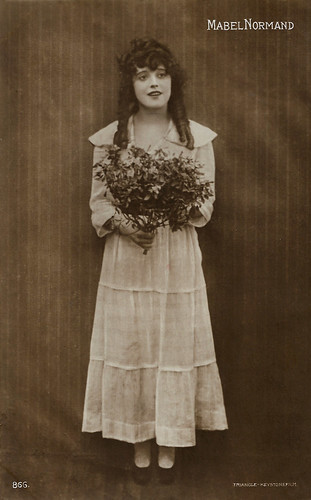
Swedish postcard by Förlag Nordisk Konst, Stockholm, no. 866. Photo: Triangle-Keystonefilm.
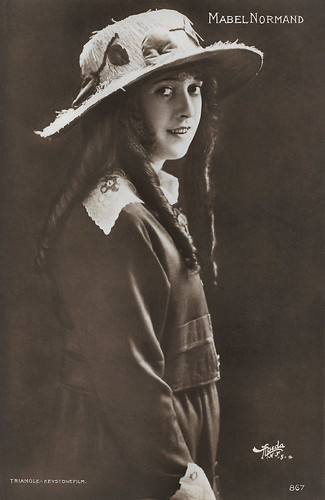
Swedish postcard by Förlag Nordisk Konst, Stockholm, no. 867. Photo: Apeda N.Y. / Triangle-Keystone Films.
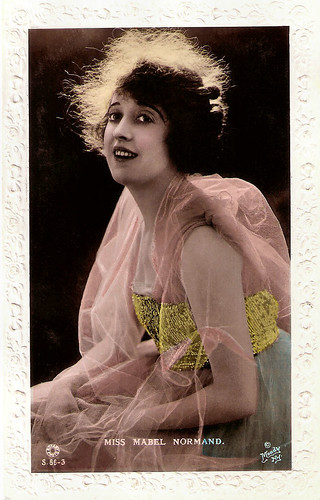
British Real Photograph postcard by Rotary Photo, London, no. S.66-3. Photo: Moody, N.Y.
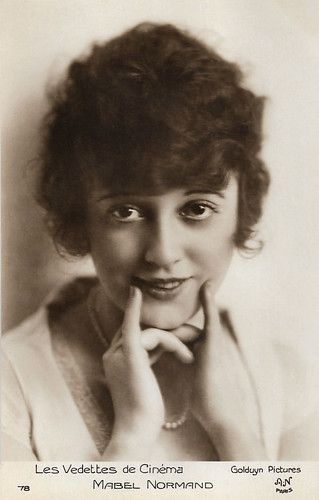
French postcard in the Les Vedettes de Cinéma series by A.N., Paris, no. 78. Photo: Goldwyn Pictures.
A beautiful woman with a talent for comedy
Mabel Normand was born Amabel Ethelreid Normand in New Brighton, Richmond County, New York (before it was incorporated into New York City) in 1892. Her father, Clodman "Claude" George Normand was employed as a cabinetmaker and stage carpenter at Sailors' Snug Harbor home for elderly seamen. Her mother was Mary "Minne" Drury. Mabel had 5 siblings, although only two survived into adulthood, the rest succumbing to tuberculosis.
Normand was a model before her career as an actress. This included posing for postcards illustrated by Charles Dana Gibson, creator of the Gibson Girl image, as well as for Butterick's clothing pattern manufacturers in lower Manhattan. She became an actress in 1910 at the Eastcoast, at Vitagraph and Biograph.
Her intensely beguiling lead performance, directed by D. W. Griffith in the short drama Her Awakening (1911), drew attention while at the Biograph Company. She met director Mack Sennett and they embarked on a topsy-turvy relationship. In 1912, Sennett took her to his new studio, Keystone in California.
At the start, Normand was primarily portrayed in films as a beautiful woman, but soon her talent for comedy was spotted. She became a highly popular comedienne in shorts with Charlie Chaplin and Fatty Arbuckle . She is credited as being the first film star to receive a pie thrown in the face.
Normand played a key role in starting Chaplin's film career and defended Chaplin before Sennett, when the latter was initially not convinced of Chaplin's acting qualities. Mabel acted as his leading lady and mentor in a string of films in 1914, sometimes co-writing and directing or co-directing films with him.
In 1914, she starred with Marie Dressler and Chaplin in Tillie's Punctured Romance (Mack Sennett, 1914), the first feature-length comedy. Earlier that same year, Chaplin first played his Tramp character in Mabel's Strange Predicament (Mabel Normand, 1914), although it wound up being the second Tramp film released. Normand directed Chaplin and herself in the film.
In 1916, Normand opened with Sennett her own company at Culver City, as a subsidiary of Triangle. When Triangle collapsed in 1918 it also took down Mabel's company and also caused Sennett to lose Keystone. In 1918 also the affair of Normand with Sennett ended.
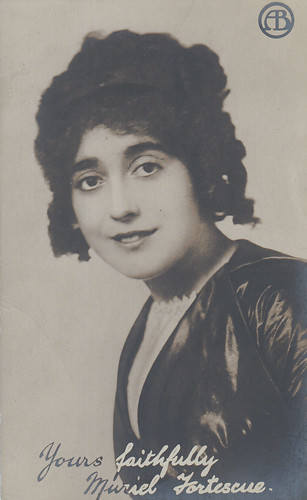
British postcard, no. 31. Photo: American Biograph. Mabel Normand as Muriel Fortescue, the name which was given to her for British audiences by the MPSA Motion Picture Sales Agency. Collection: Marlene Pilaete.

British postcard in the series "Keystone cards presented with Home Weekly". Photo: Keystone Film. Mabel Normand in The Sea Nymphs (Mack Sennett, 1914). Caption: Mabel as a sea nymph.
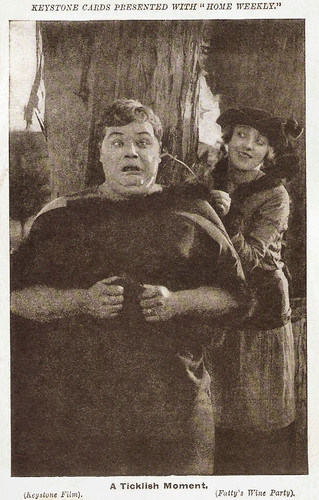
American postcard by Keystone cards, presented with Home Weekly. Photo: Keystone Film. Publicity still for Fatty's Wine Party (Roscoe 'Fatty' Arbuckle, 1914) with Fatty Arbuckle and Mabel Normand. Caption: A Ticklish Moment.
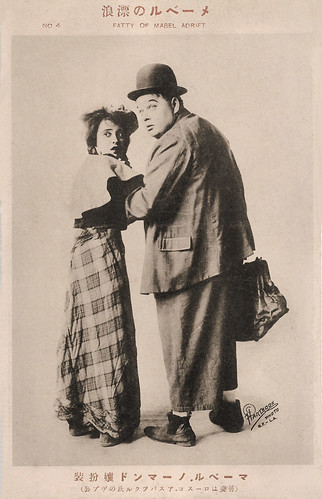
Chinese postcard, no. 4. Photo: Hartsook Photo, S.F. - L.A. / Keystone Film. Fatty Arbuckle and Mabel Normand in Fatty and Mabel Adrift (Roscoe 'Fatty' Arbuckle, 1916).
The Murder of William Desmond Taylor
Mabel Normand got a new contract with Samuel Goldwyn. Yet her popularity and health declined. Normand became unhappy and became addicted to alcohol and drugs. Director William Desmond Taylor noticed this and tried to help her. This led to a relationship.
In 1922, William Desmond Taylor was killed, 15 minutes after Normand left the house. Since the murder was never unraveled, Normand was suspected by the police. There was also speculation that Normand's cocaine sellers may have been involved, as Taylor had repeatedly helped her to get off her drug addiction and wanted to file charges against her suppliers.
Many suspects of the murder are known but despite a confession of actress Margaret Gibson on her deathbed, the case is still open. Kevin Brownlow and John Kobal in their book 'Hollywood: The Pioneers' claim there is no real proof of Normand's drug addiction and the idea that Taylor was murdered by drug dealers was invented by the studio for publicity purposes.
Mabel Normand became involved in another scandal when her driver Joe Kelly (also an ex-criminal) shot millionaire oil broker and amateur golfer Courtland S. Dines, one of Normand's lovers with Normand's gun. Normand was hated by the media, several theatres pulled Normand's films, and her films were banned in Ohio by the state film censorship board. In 1923, she decided to end her career.
Still, she got a second chance when Hal Roach Studios offered her a contract in 1926. At Roach, she made the short comedies Raggedy Rose (Richard Wallace, 1926), The Nickel-Hopper (F. Richard Jones, Hal Yates, 1926), and One Hour Married (Jerome Strong, 1926). All were co-written by Stan Laurel . She was also directed by Leo McCarey in Should Men Walk Home? (1927) with Creighton Hale and Oliver Hardy . She received a lot of publicity, but her scandals from her past resurfaced and Normand's career was now definitively destroyed.
In 1930, Mabel Normand died of tuberculosis at the age of 37. She was married in 1926 to actor Lew Cody, with whom she had appeared in the film Mickey (F. Richard Jones, James Young, 1918). She was interred as Mabel Normand-Cody at Calvary Cemetery, Los Angeles. Cody died four years after Normand because of a heart attack.
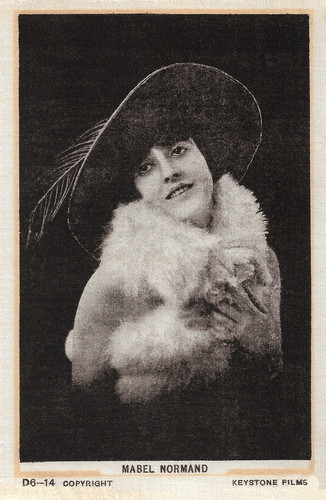
British postcard in the Novelty Series, no. D6-14. Photo: Keystone Films.
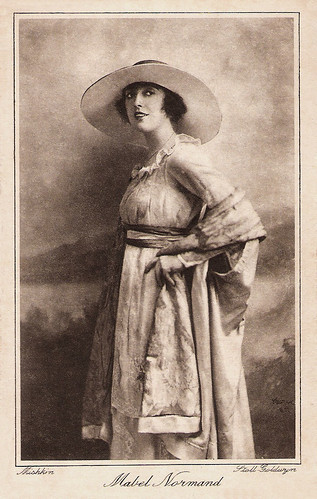
British postcard in the Cinema Chat series. Photo: Mishkin / Stoll Goldwyn.
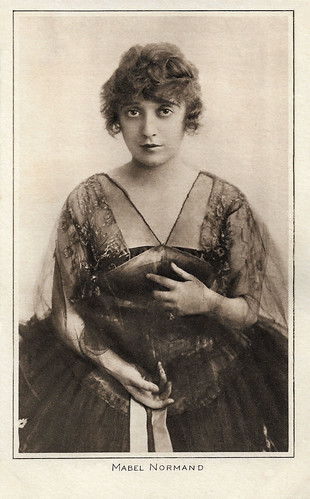
British postcard in the 'Pictures' Portrait Gallery by Pictures Ltd., London, no. 120.
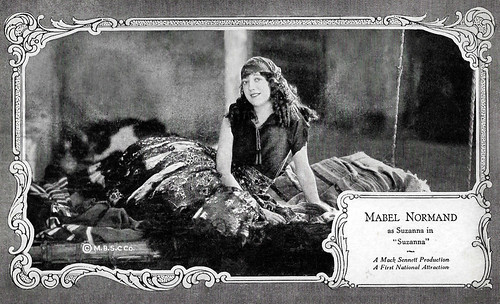
American postcard by Max B. Sheffer Card Co., Chicago (M.B.S.C.Co.). Photo: Mack Sennett Production / First National. Mabel Normand as Suzanna in Suzanna (F. Richard Jones, 1923).
Sources: Wikipedia (Dutch, and English), and .

Swedish postcard by Förlag Nordisk Konst, Stockholm, no. 866. Photo: Triangle-Keystonefilm.

Swedish postcard by Förlag Nordisk Konst, Stockholm, no. 867. Photo: Apeda N.Y. / Triangle-Keystone Films.

British Real Photograph postcard by Rotary Photo, London, no. S.66-3. Photo: Moody, N.Y.

French postcard in the Les Vedettes de Cinéma series by A.N., Paris, no. 78. Photo: Goldwyn Pictures.
A beautiful woman with a talent for comedy
Mabel Normand was born Amabel Ethelreid Normand in New Brighton, Richmond County, New York (before it was incorporated into New York City) in 1892. Her father, Clodman "Claude" George Normand was employed as a cabinetmaker and stage carpenter at Sailors' Snug Harbor home for elderly seamen. Her mother was Mary "Minne" Drury. Mabel had 5 siblings, although only two survived into adulthood, the rest succumbing to tuberculosis.
Normand was a model before her career as an actress. This included posing for postcards illustrated by Charles Dana Gibson, creator of the Gibson Girl image, as well as for Butterick's clothing pattern manufacturers in lower Manhattan. She became an actress in 1910 at the Eastcoast, at Vitagraph and Biograph.
Her intensely beguiling lead performance, directed by D. W. Griffith in the short drama Her Awakening (1911), drew attention while at the Biograph Company. She met director Mack Sennett and they embarked on a topsy-turvy relationship. In 1912, Sennett took her to his new studio, Keystone in California.
At the start, Normand was primarily portrayed in films as a beautiful woman, but soon her talent for comedy was spotted. She became a highly popular comedienne in shorts with Charlie Chaplin and Fatty Arbuckle . She is credited as being the first film star to receive a pie thrown in the face.
Normand played a key role in starting Chaplin's film career and defended Chaplin before Sennett, when the latter was initially not convinced of Chaplin's acting qualities. Mabel acted as his leading lady and mentor in a string of films in 1914, sometimes co-writing and directing or co-directing films with him.
In 1914, she starred with Marie Dressler and Chaplin in Tillie's Punctured Romance (Mack Sennett, 1914), the first feature-length comedy. Earlier that same year, Chaplin first played his Tramp character in Mabel's Strange Predicament (Mabel Normand, 1914), although it wound up being the second Tramp film released. Normand directed Chaplin and herself in the film.
In 1916, Normand opened with Sennett her own company at Culver City, as a subsidiary of Triangle. When Triangle collapsed in 1918 it also took down Mabel's company and also caused Sennett to lose Keystone. In 1918 also the affair of Normand with Sennett ended.

British postcard, no. 31. Photo: American Biograph. Mabel Normand as Muriel Fortescue, the name which was given to her for British audiences by the MPSA Motion Picture Sales Agency. Collection: Marlene Pilaete.

British postcard in the series "Keystone cards presented with Home Weekly". Photo: Keystone Film. Mabel Normand in The Sea Nymphs (Mack Sennett, 1914). Caption: Mabel as a sea nymph.

American postcard by Keystone cards, presented with Home Weekly. Photo: Keystone Film. Publicity still for Fatty's Wine Party (Roscoe 'Fatty' Arbuckle, 1914) with Fatty Arbuckle and Mabel Normand. Caption: A Ticklish Moment.

Chinese postcard, no. 4. Photo: Hartsook Photo, S.F. - L.A. / Keystone Film. Fatty Arbuckle and Mabel Normand in Fatty and Mabel Adrift (Roscoe 'Fatty' Arbuckle, 1916).
The Murder of William Desmond Taylor
Mabel Normand got a new contract with Samuel Goldwyn. Yet her popularity and health declined. Normand became unhappy and became addicted to alcohol and drugs. Director William Desmond Taylor noticed this and tried to help her. This led to a relationship.
In 1922, William Desmond Taylor was killed, 15 minutes after Normand left the house. Since the murder was never unraveled, Normand was suspected by the police. There was also speculation that Normand's cocaine sellers may have been involved, as Taylor had repeatedly helped her to get off her drug addiction and wanted to file charges against her suppliers.
Many suspects of the murder are known but despite a confession of actress Margaret Gibson on her deathbed, the case is still open. Kevin Brownlow and John Kobal in their book 'Hollywood: The Pioneers' claim there is no real proof of Normand's drug addiction and the idea that Taylor was murdered by drug dealers was invented by the studio for publicity purposes.
Mabel Normand became involved in another scandal when her driver Joe Kelly (also an ex-criminal) shot millionaire oil broker and amateur golfer Courtland S. Dines, one of Normand's lovers with Normand's gun. Normand was hated by the media, several theatres pulled Normand's films, and her films were banned in Ohio by the state film censorship board. In 1923, she decided to end her career.
Still, she got a second chance when Hal Roach Studios offered her a contract in 1926. At Roach, she made the short comedies Raggedy Rose (Richard Wallace, 1926), The Nickel-Hopper (F. Richard Jones, Hal Yates, 1926), and One Hour Married (Jerome Strong, 1926). All were co-written by Stan Laurel . She was also directed by Leo McCarey in Should Men Walk Home? (1927) with Creighton Hale and Oliver Hardy . She received a lot of publicity, but her scandals from her past resurfaced and Normand's career was now definitively destroyed.
In 1930, Mabel Normand died of tuberculosis at the age of 37. She was married in 1926 to actor Lew Cody, with whom she had appeared in the film Mickey (F. Richard Jones, James Young, 1918). She was interred as Mabel Normand-Cody at Calvary Cemetery, Los Angeles. Cody died four years after Normand because of a heart attack.

British postcard in the Novelty Series, no. D6-14. Photo: Keystone Films.

British postcard in the Cinema Chat series. Photo: Mishkin / Stoll Goldwyn.

British postcard in the 'Pictures' Portrait Gallery by Pictures Ltd., London, no. 120.

American postcard by Max B. Sheffer Card Co., Chicago (M.B.S.C.Co.). Photo: Mack Sennett Production / First National. Mabel Normand as Suzanna in Suzanna (F. Richard Jones, 1923).
Sources: Wikipedia (Dutch, and English), and .
Published on May 30, 2021 22:00
May 29, 2021
Les amours imaginaires (2010)
The French romantic drama Les amours imaginaires/Heartbeats (2010) tells the story of three close friends who are involved in a love-triangle. It was the second film of the young Canadian filmmaker Xavier Dolan.
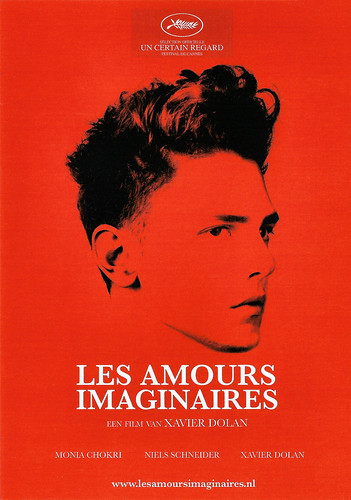
Dutch postcard. Poster for Les amours imaginaires (Xavier Dolan, 2010).
Tales of romantic pitfalls
Les amours imaginaires/Heartbeats (2010) tells a story interspersed with interview tales of romantic pitfalls. Friendship turns to romantic rivalry for gay man Francis (Xavier Dolan) and straight woman Marie (Monia Chokri) when a veritable Adonis named Nicolas (Niels Schneider) enters their lives.
Sexual tensions mount as Francis and Marie await Nicolas' show of preference. The two friends each begin taking bolder steps in hopes of earning Nicolas' attention until their rivalry threatens to destroy their friendship.
Les amours imaginaires was directed by the then 21-year-old Canadian Xavier Dolan. Mike Goodrich at Screen Daily : "A ménage a trois that owes as much to contemporary French cineastes like Ozon, Honore, and Lifshitz as it does to Jules And Jim, Heartbeats proves that Dolan is no flash in the pan and should build his reputation on the international festival circuit."
Mark Deming at AllMovie : "Heartbeats is clearly Xavier Dolan's show - he starred in, wrote, produced, edited, and directed the film as well as coordinating the costumes, and cinematographer Stéphanie Anne Weber Biron lavishes as much mood lighting and flattering angles on the auteur as on his co-stars Monia Chokri and Niels Schneider, both of whom frankly have a natural advantage in the good-looks department.
As an actor, Dolan brings a callow arrogance to his character that suits him well, and Chokri is a good match as the edgy and self-obsessed Marie, who, as hard as she tries, never seems fully convinced of her very real allure.
Niels Schneider is given the task of playing a man who is at once handsome, charming, and utterly blank, and he manages all three quite well; it's hard to say how much of this is acting and how much is the natural effect of a guy who really doesn't care, but whatever it is, it works onscreen."
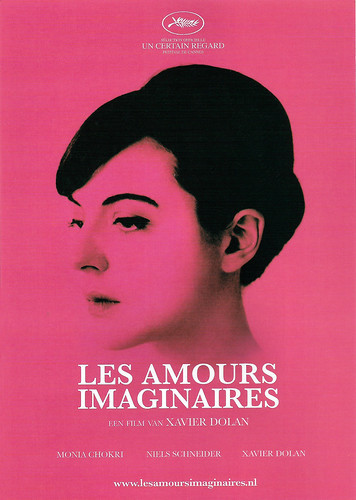
Dutch postcard. Poster for Les amours imaginaires (Xavier Dolan, 2010).
Alternately infuriating and delicious
Xavier Dolan had stormed onto the international scene with his debut J'ai tué ma mere/I killed My Mother (2009) for which he won three awards at the Cannes Film Festival.
Les amours imaginaires/Heartbeats (2010) was his follow-up. Mike Goodrich at Screen Daily : "The second film from the precociously talented 21-year-old Canadian Xavier Dolan is alternately infuriating and delicious. While Dolan’s visual tricksiness and mannerisms wear on the patience, he does achieve occasional moments of visual poetry and, appropriately bearing in mind his age, captures the despair and longing of young heartache."
Mark Deming at AllMovie : "As the film veers from comedy into something deeper and darker, Chokri and Dolan guide their characters well, and as a director, Dolan handles the tonal shifts of the narrative and the emotional ups and downs of the characters with confidence, though his sense of pacing isn't always quite as solid, as the film drags in the second act."
The film premiered in the Un Certain Regard category at the 63e Festival de Cannes in May 2010 where it received a standing ovation. It won the top prize of the Official Competition at the Sydney Film Festival in June and screened at several film festivals throughout 2011, but failed to find audiences in non-French-speaking countries.
Nowadays, only 31, Xavier Dolan has written and directed eight feature films. Dolan has won many awards for his work, including the Jury Prize at the 2014 Cannes Film Festival for Mommy (2014) and the Grand Prix at the 2016 Cannes Film Festival for It's Only the End of the World (2016). He has also won several Canadian Screen Awards and César Awards.
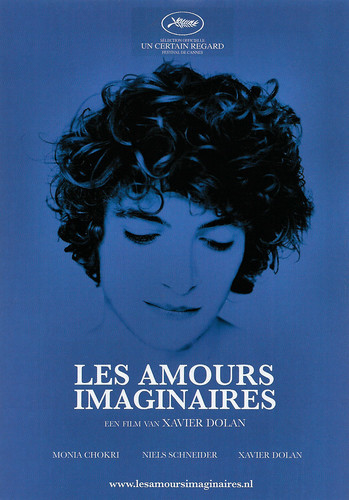
Dutch postcard. Poster for Les amours imaginaires (Xavier Dolan, 2010).
Trailer Les amours imaginaires/Heartbeats (2010). Source: MovieFans.tumblr.com. (YouTube).
Sources: Mark Deming (AllMovie), Mike Goodrich (Screen Daily), AllMovie, Wikipedia, and IMDb.

Dutch postcard. Poster for Les amours imaginaires (Xavier Dolan, 2010).
Tales of romantic pitfalls
Les amours imaginaires/Heartbeats (2010) tells a story interspersed with interview tales of romantic pitfalls. Friendship turns to romantic rivalry for gay man Francis (Xavier Dolan) and straight woman Marie (Monia Chokri) when a veritable Adonis named Nicolas (Niels Schneider) enters their lives.
Sexual tensions mount as Francis and Marie await Nicolas' show of preference. The two friends each begin taking bolder steps in hopes of earning Nicolas' attention until their rivalry threatens to destroy their friendship.
Les amours imaginaires was directed by the then 21-year-old Canadian Xavier Dolan. Mike Goodrich at Screen Daily : "A ménage a trois that owes as much to contemporary French cineastes like Ozon, Honore, and Lifshitz as it does to Jules And Jim, Heartbeats proves that Dolan is no flash in the pan and should build his reputation on the international festival circuit."
Mark Deming at AllMovie : "Heartbeats is clearly Xavier Dolan's show - he starred in, wrote, produced, edited, and directed the film as well as coordinating the costumes, and cinematographer Stéphanie Anne Weber Biron lavishes as much mood lighting and flattering angles on the auteur as on his co-stars Monia Chokri and Niels Schneider, both of whom frankly have a natural advantage in the good-looks department.
As an actor, Dolan brings a callow arrogance to his character that suits him well, and Chokri is a good match as the edgy and self-obsessed Marie, who, as hard as she tries, never seems fully convinced of her very real allure.
Niels Schneider is given the task of playing a man who is at once handsome, charming, and utterly blank, and he manages all three quite well; it's hard to say how much of this is acting and how much is the natural effect of a guy who really doesn't care, but whatever it is, it works onscreen."

Dutch postcard. Poster for Les amours imaginaires (Xavier Dolan, 2010).
Alternately infuriating and delicious
Xavier Dolan had stormed onto the international scene with his debut J'ai tué ma mere/I killed My Mother (2009) for which he won three awards at the Cannes Film Festival.
Les amours imaginaires/Heartbeats (2010) was his follow-up. Mike Goodrich at Screen Daily : "The second film from the precociously talented 21-year-old Canadian Xavier Dolan is alternately infuriating and delicious. While Dolan’s visual tricksiness and mannerisms wear on the patience, he does achieve occasional moments of visual poetry and, appropriately bearing in mind his age, captures the despair and longing of young heartache."
Mark Deming at AllMovie : "As the film veers from comedy into something deeper and darker, Chokri and Dolan guide their characters well, and as a director, Dolan handles the tonal shifts of the narrative and the emotional ups and downs of the characters with confidence, though his sense of pacing isn't always quite as solid, as the film drags in the second act."
The film premiered in the Un Certain Regard category at the 63e Festival de Cannes in May 2010 where it received a standing ovation. It won the top prize of the Official Competition at the Sydney Film Festival in June and screened at several film festivals throughout 2011, but failed to find audiences in non-French-speaking countries.
Nowadays, only 31, Xavier Dolan has written and directed eight feature films. Dolan has won many awards for his work, including the Jury Prize at the 2014 Cannes Film Festival for Mommy (2014) and the Grand Prix at the 2016 Cannes Film Festival for It's Only the End of the World (2016). He has also won several Canadian Screen Awards and César Awards.

Dutch postcard. Poster for Les amours imaginaires (Xavier Dolan, 2010).
Trailer Les amours imaginaires/Heartbeats (2010). Source: MovieFans.tumblr.com. (YouTube).
Sources: Mark Deming (AllMovie), Mike Goodrich (Screen Daily), AllMovie, Wikipedia, and IMDb.
Published on May 29, 2021 22:00
May 28, 2021
More J.R.P.R.
Last year, we had a beautiful post on French postcard publisher J.R.P.R. We love the sepia cards of this Paris-based company which produced more than 500 postcards with international stars or scenes of classic films. The French photos were mostly shot by either Studio Lorelle or Studio G.L. Manuel Frères. The J.R.P.R. series not only contains actors from stage and screen but also dancers, aviators and sports heroes such as boxers, jockeys, and football players. For this post, we selected 21 postcards that we recently acquired.
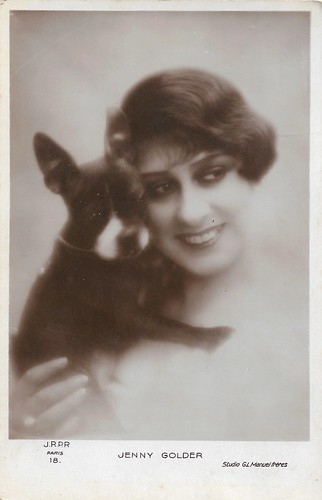
French postcard by J.R.P.R., Paris, no. 18. Photo: G.L. Manuel Frères. Jenny Golder, originally Rosie Sloman, was born in 1894 in Kyneton, Victoria, Australia. Her father was a jack of all trades: theatre director, magician, bookmaker, etc., while her mother's name was Golder. In the late 19th century they moved to Britain and lived in Brighton. In the 1920s under the name of Jenny Golder, Rosie Sloman became a popular vaudeville vedette first in London and Brussels, but eventually, it was in Paris she had her biggest triumphs. She appeared in many revues with American dancer Harry Pilcer, the former dance partner of Gaby Deslys. In 1925 she had her greatest success with the Folies Bergères revue at the London Palladium. However, in 1928 she committed suicide in her villa in Vesinet by shooting herself. Some say she was overworked, others speculate that after an operation on her leg she was afraid she couldn't act anymore. As far is known, Golder didn't act in a film.
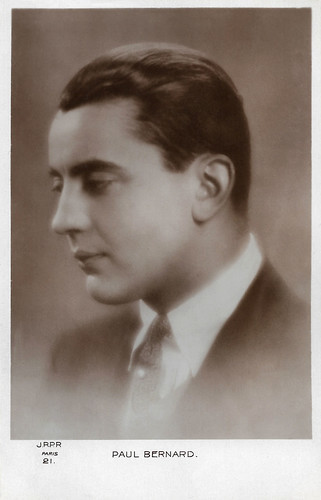
French postcard by J.R.P.R., Paris, no. 21. Paul Bernard (1898-1958) was a French actor, who appeared in thirty-five films between 1922 and 1958. His films included the silent serial film Les mystères de Paris/The Mysteries of Paris (Charles Burguet, 1922), and the drama Un ami viendra ce soir/A Friend Will Come Tonight (Raymond Bernard, 1946).
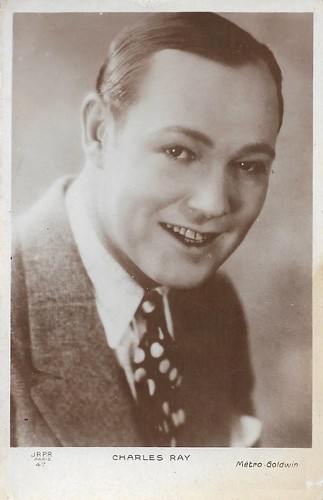
Charles Ray . French postcard by J.R.P.R., Paris, no. 47. Photo: Metro-Goldwyn [misspelled].
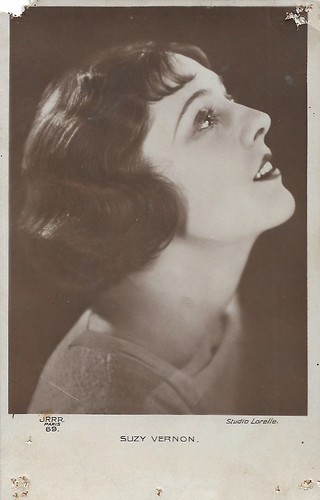
Suzy Vernon . French postcard by J.R.P.R., Paris, no. 69. Photo: Studio Lorelle.

French postcard by J.R.P.R., Paris, no. 80. Photo: G.L. Manuel Frères. Henry Roussel (1875–1946), also known as Henry Roussell, was a French silent film actor, film director, and screenwriter best known for his silent films of the 1910s and 1920s. He starred in well over 40 films between 1912 and 1939 and directed such films as Visages voilés... âmes closes (1921), Les opprimés (1923), Violettes impériales/Imperial Violets (1924) and Paris' Girls (1929), while in the early 1910s he was a regular actor of the Eclair company, often directed by Maurice Tourneur, and later on had memorable parts in e.g. Les nouveaux messieurs (1929).
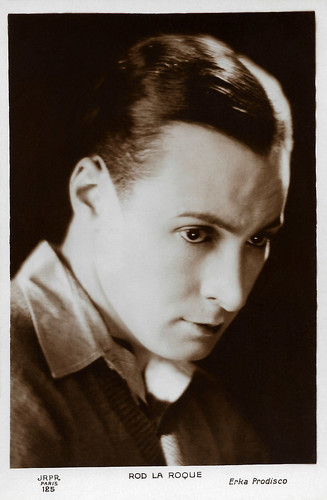
Rod La Rocque. French postcard by J.R.P.R, Paris, no. 125. Photo: Erka Prodisco.
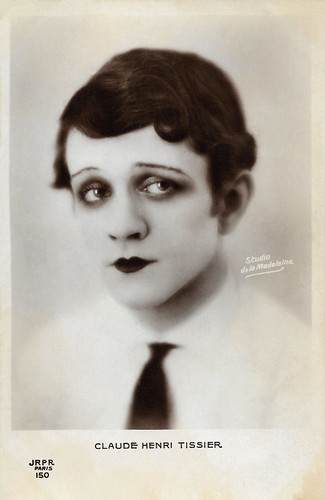
Claude-Henri Tissier. French postcard by J.R.P.R., Paris, no. 150. Photo: Studio de la Madeleine.
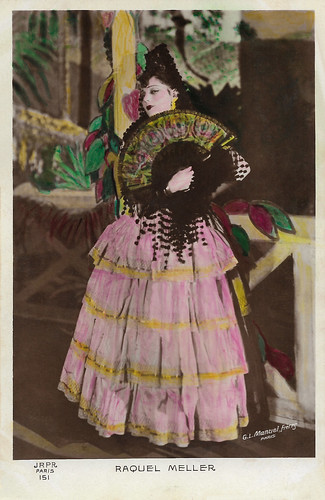
Raquel Meller . French postcard by J.R.P.R., Paris, no. 151. Photo: G.L. Manuel Frères, Paris.
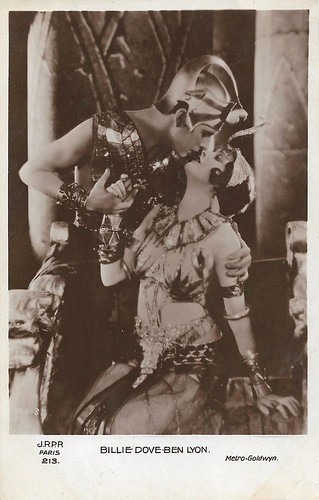
French postcard by J.R.P.R., no. 213. Photo: Metro-Goldwyn. Ben Lyon and Billie Dove in The Tender Hour (George Fitzmaurice, 1927). NB. The film was a First National production, not an MGM film.
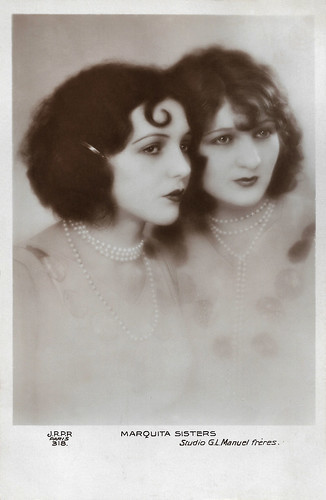
French postcard by J.R.P.R., Paris, no. 318. Photo: Studio G.L. Manuel Frères. The Marquita Sisters was a beautiful dancing duo around 1925. We could find more pictures of them on the net, but no more information.
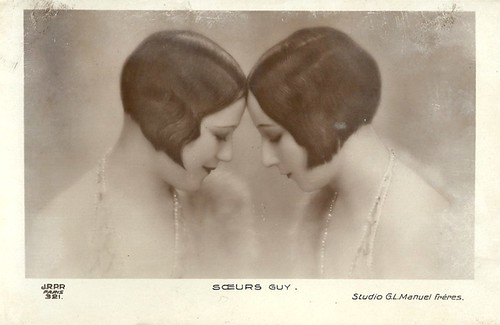
French postcard by J.R.P.R., no. 321. Photo G.L. Manuel Frères. The sisters Mary and Christiane Guy performed in the 1920s in Paris music-halls, with their sister Edmonde, and her dance partner Ernest Van Duren. They were popular revue dancers at the Paris Palace Theatre.
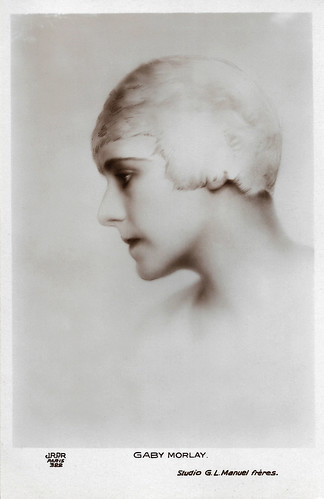
Gaby Morlay . French postcard by J.R.P.R., Paris, no. 322. Photo: Studio G.L. Manuel Frères.
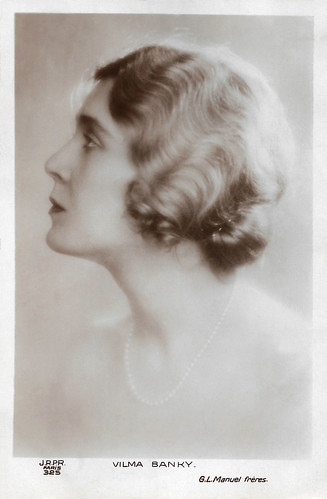
Vilma Bánky . French postcard by J.R.P.R., Paris, no. 325. Photo: Studio G.L. Manuel Frères.
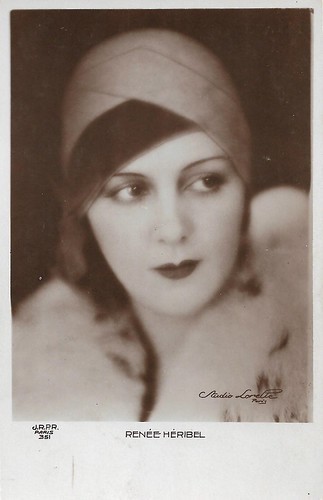
French postcard by J.R.P.R., Paris, no. 351. Photo: Studio Lorelle, Paris. French actress Renée Héribel (1903-1952) knew to launch a short but impressive film career in the second half of the 1920s.
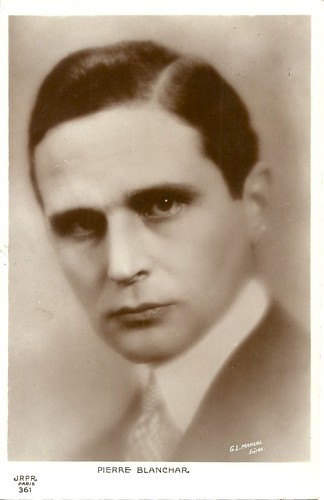
Pierre Blanchar . French postcard by J.R.P.R., Paris, no. 361. Photo: G.L. Manuel Frères.
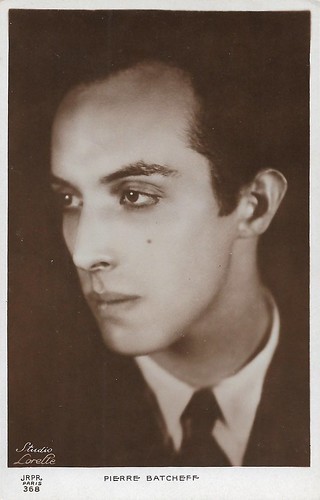
Pierre Batcheff . French postcard by J.R.P.R., Paris, no. 368. Photo: Studio Lorelle.
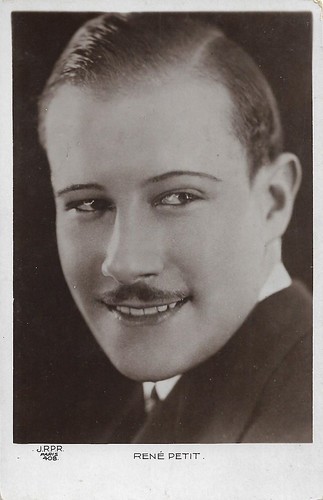
French postcard by J.R.P.R., Paris, no. 408. This card may well not refer to an actor but to a popular French-Spanish football (soccer) player known as René Petit (1899-1989), credited to have modernised Spanish football between the 1910s and 1930s. In 1920 he joined the French national equipe for the Olympic Games. In the 1930s he was active in Spain as an engineer too.
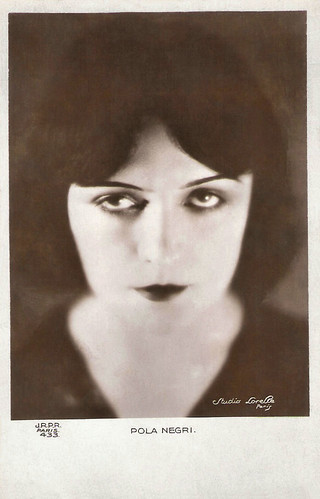
Pola Negri . French postcard by J.R.P.R., Paris, no. 433. Photo: Studio Lorelle, Paris.
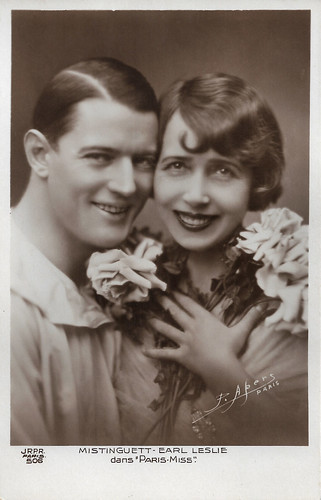
French postcard by J.R.P.R., Paris, no. 506. Photo: P. Apers. Mistinguett and Earl Leslie in the revue ' Paris Miss' at the Casino de Paris in 1930.
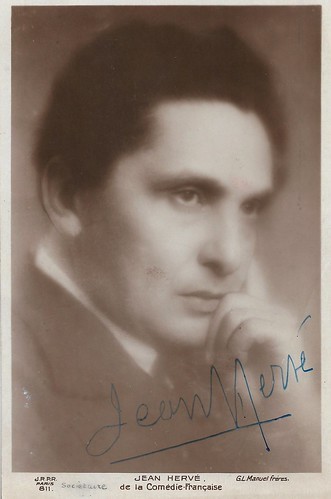
French postcard by J.R.P.R., Paris, no. 811. Photo: G.L. Manuel Frères. Caption: Jean Hervé de la Comédie Française. In 1925 Jean Hervé (1884-1966) became sociétaire at the Comédie Française, so the card may have been from before 1925, after which the handwritten word Sociétaire was added. Hervé was also known for his parts in film d'art cinema, the Rocambole films, La Terre (1921) and Feu Mathias Pascal (1926). Card signed by the artist.
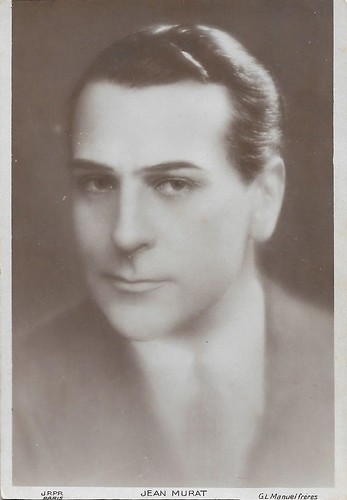
Jean Murat . French postcard by J.R.P.R., Paris, no. ? Photo: G.L. Manuel Frères.
More? Check out our earlier J.R.P.R. post. At Ross Postcards, Jean Ritsema made a checklist of the J.R.P.R. collection.

French postcard by J.R.P.R., Paris, no. 18. Photo: G.L. Manuel Frères. Jenny Golder, originally Rosie Sloman, was born in 1894 in Kyneton, Victoria, Australia. Her father was a jack of all trades: theatre director, magician, bookmaker, etc., while her mother's name was Golder. In the late 19th century they moved to Britain and lived in Brighton. In the 1920s under the name of Jenny Golder, Rosie Sloman became a popular vaudeville vedette first in London and Brussels, but eventually, it was in Paris she had her biggest triumphs. She appeared in many revues with American dancer Harry Pilcer, the former dance partner of Gaby Deslys. In 1925 she had her greatest success with the Folies Bergères revue at the London Palladium. However, in 1928 she committed suicide in her villa in Vesinet by shooting herself. Some say she was overworked, others speculate that after an operation on her leg she was afraid she couldn't act anymore. As far is known, Golder didn't act in a film.

French postcard by J.R.P.R., Paris, no. 21. Paul Bernard (1898-1958) was a French actor, who appeared in thirty-five films between 1922 and 1958. His films included the silent serial film Les mystères de Paris/The Mysteries of Paris (Charles Burguet, 1922), and the drama Un ami viendra ce soir/A Friend Will Come Tonight (Raymond Bernard, 1946).

Charles Ray . French postcard by J.R.P.R., Paris, no. 47. Photo: Metro-Goldwyn [misspelled].

Suzy Vernon . French postcard by J.R.P.R., Paris, no. 69. Photo: Studio Lorelle.

French postcard by J.R.P.R., Paris, no. 80. Photo: G.L. Manuel Frères. Henry Roussel (1875–1946), also known as Henry Roussell, was a French silent film actor, film director, and screenwriter best known for his silent films of the 1910s and 1920s. He starred in well over 40 films between 1912 and 1939 and directed such films as Visages voilés... âmes closes (1921), Les opprimés (1923), Violettes impériales/Imperial Violets (1924) and Paris' Girls (1929), while in the early 1910s he was a regular actor of the Eclair company, often directed by Maurice Tourneur, and later on had memorable parts in e.g. Les nouveaux messieurs (1929).

Rod La Rocque. French postcard by J.R.P.R, Paris, no. 125. Photo: Erka Prodisco.

Claude-Henri Tissier. French postcard by J.R.P.R., Paris, no. 150. Photo: Studio de la Madeleine.

Raquel Meller . French postcard by J.R.P.R., Paris, no. 151. Photo: G.L. Manuel Frères, Paris.

French postcard by J.R.P.R., no. 213. Photo: Metro-Goldwyn. Ben Lyon and Billie Dove in The Tender Hour (George Fitzmaurice, 1927). NB. The film was a First National production, not an MGM film.

French postcard by J.R.P.R., Paris, no. 318. Photo: Studio G.L. Manuel Frères. The Marquita Sisters was a beautiful dancing duo around 1925. We could find more pictures of them on the net, but no more information.

French postcard by J.R.P.R., no. 321. Photo G.L. Manuel Frères. The sisters Mary and Christiane Guy performed in the 1920s in Paris music-halls, with their sister Edmonde, and her dance partner Ernest Van Duren. They were popular revue dancers at the Paris Palace Theatre.

Gaby Morlay . French postcard by J.R.P.R., Paris, no. 322. Photo: Studio G.L. Manuel Frères.

Vilma Bánky . French postcard by J.R.P.R., Paris, no. 325. Photo: Studio G.L. Manuel Frères.

French postcard by J.R.P.R., Paris, no. 351. Photo: Studio Lorelle, Paris. French actress Renée Héribel (1903-1952) knew to launch a short but impressive film career in the second half of the 1920s.

Pierre Blanchar . French postcard by J.R.P.R., Paris, no. 361. Photo: G.L. Manuel Frères.

Pierre Batcheff . French postcard by J.R.P.R., Paris, no. 368. Photo: Studio Lorelle.

French postcard by J.R.P.R., Paris, no. 408. This card may well not refer to an actor but to a popular French-Spanish football (soccer) player known as René Petit (1899-1989), credited to have modernised Spanish football between the 1910s and 1930s. In 1920 he joined the French national equipe for the Olympic Games. In the 1930s he was active in Spain as an engineer too.

Pola Negri . French postcard by J.R.P.R., Paris, no. 433. Photo: Studio Lorelle, Paris.

French postcard by J.R.P.R., Paris, no. 506. Photo: P. Apers. Mistinguett and Earl Leslie in the revue ' Paris Miss' at the Casino de Paris in 1930.

French postcard by J.R.P.R., Paris, no. 811. Photo: G.L. Manuel Frères. Caption: Jean Hervé de la Comédie Française. In 1925 Jean Hervé (1884-1966) became sociétaire at the Comédie Française, so the card may have been from before 1925, after which the handwritten word Sociétaire was added. Hervé was also known for his parts in film d'art cinema, the Rocambole films, La Terre (1921) and Feu Mathias Pascal (1926). Card signed by the artist.

Jean Murat . French postcard by J.R.P.R., Paris, no. ? Photo: G.L. Manuel Frères.
More? Check out our earlier J.R.P.R. post. At Ross Postcards, Jean Ritsema made a checklist of the J.R.P.R. collection.
Published on May 28, 2021 22:00
May 27, 2021
Paul Newman
American film actor Paul Newman (1925-2008) was a matinee idol with the most famous blue eyes of Hollywood, who often played detached yet charismatic anti-heroes and rebels. He was nominated for nine acting Academy Awards in five different decades and won the Oscar for The Color of Money (1986). He was also a prominent social activist, a major proponent of actors' creative rights, and a noted philanthropist.
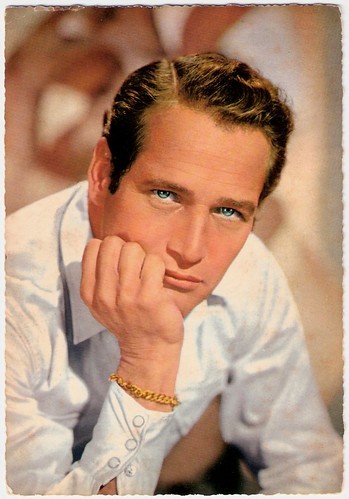
German postcard by Krüger, no. 902/261.
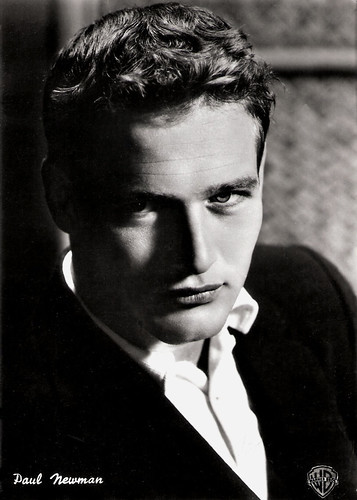
Italian postcard by Bromofoto, Milano, no. 1412. Photo: Warner Bros.
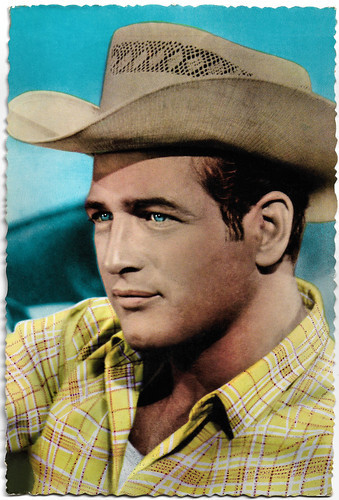
Spanish postcard by Archivo Bermejo, no. C.6., 1963 Photo: Paramount / Filmax. Photo: Paul Newman in Hud (Martin Ritt, 1963).
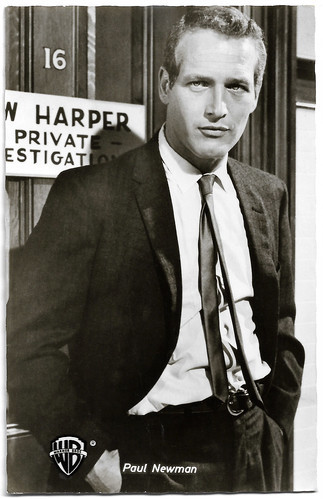
West-German Kolibri postcard by Friedrich W. Sander-Verlag, Minden/Westf., no. 2863. Photo: Warner Bros. Paul Newman in Harper (Jack Smight, 1966).
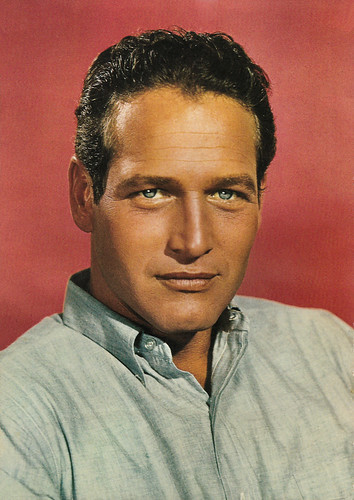
Italian postcard by Edizioni Beatrice D'Este, no. 20020. Sent by mail in 1984.

American postcard by Fan Club Post Cards, New York, N.Y., no. PC 22. Paul Newman and Robert Redford in Butch Cassidy and the Sundance Kid (George Roy Hill, 1969).
The much admired and popular New York Actors Studio
Paul Leonard Newman was born in 1925, in Shaker Heights, Ohio, a suburb of Cleveland. He was the second son of Arthur Sigmund Newman and Theresa Fetsko. His father was a Jewish businessman who owned a successful sporting goods store. His mother was a practicing Christian Scientist with an interest in the creative arts, and it rubbed off on her son.
At age 10, he performed in a stage production of 'Saint George and the Dragon' at the Cleveland Play House. He also acted in high school plays.
By 1950, the 25-year-old Newman had been kicked out of Ohio University, where he belonged to the Phi Kappa Tau fraternity, for unruly behavior (denting the college president's car with a beer keg), served three years in the United States Navy during World War II as a radio operator, graduated from Ohio's Kenyon College, married his first wife, actress Jacqueline 'Jackie' Witte, and had his first child, Scott.
That same year, his father died. When he became successful in later years, Newman said if he had any regrets it would be that his father was not around to witness his success. He brought Jackie back to Shaker Heights and he ran his father's store for a short period.
Then, knowing that wasn't the career path he wanted to take, he sold his interest in the store to his brother and moved with Jackie and Scott to New Haven, Connecticut. There he attended Yale University's School of Drama. While doing a play there, Newman was spotted by two agents, who invited him to come to New York City to pursue a career as a professional actor.
After moving to New York, he acted in guest spots for various television series, and in 1953 came a big break. He got the part of understudy of the lead role in the successful Broadway play 'Picnic' by William Inge. Through this play, he met actress Joanne Woodward, who was also an understudy in the play. While they got on very well and there was a strong attraction, Newman was married and his second child, Susan, was born that year.
During this time, Newman was accepted into the much admired and popular New York Actors Studio, although he did not actually audition. In 1954, a film Newman was very reluctant to do was released, the failed costume drama The Silver Chalice (Victor Saville, 1954). He considered his performance in this costume epic to be so bad that he took out a full-page ad in Variety apologising for it to anyone who might have seen it. He immediately wanted to return to the stage, and performed in 'The Desperate Hours'.
In 1956, he got the chance to redeem himself in the film world by portraying boxer Rocky Graziano in Somebody Up There Likes Me (Robert Wise, 1956) with Pier Angeli . The role of Rocky was originally awarded to James Dean , who died before filming began. Critics praised Newman's performance.
Dean also was signed to play Billy the Kid in The Left Handed Gun (Arthur Penn, 1958), but that role was also inherited by Newman after Dean's death. With a handful of films to his credit, he was cast in The Long, Hot Summer (1958), an acclaimed adaptation of a pair of William Faulkner short stories. His co-star was Joanne Woodward.
During the shooting of this film, they realised they were meant to be together and by now, so did his then-wife Jackie, who gave Newman a divorce. He and Woodward wed in Las Vegas in January 1958. They went on to have three daughters together. They raised them in Westport, Connecticut. In 1959, Newman received his first Academy Award nomination for Best Actor, in Cat on a Hot Tin Roof (Richard Brooks, 1958), based on the Pulitzer Prize-winning play by Tennessee Williams. Well-received by both critics and audiences, Cat on Hot Tin Roof was MGM's most successful release of 1958 and became the third highest-grossing film of that year.
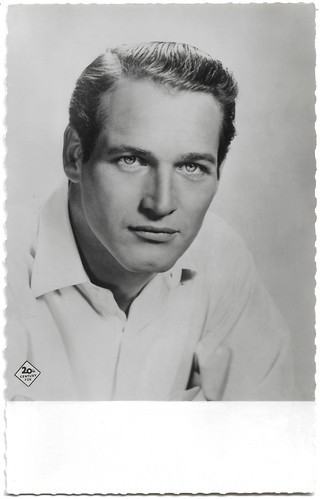
French postcard by Editions P.I., Paris, offered by Les Carbones Korès 'Carboplane', no. 945. Photo: 20th Century Fox.
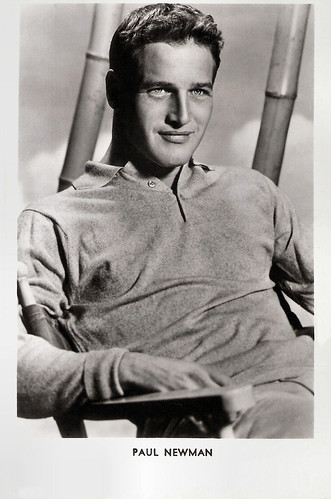
Belgian postcard, no. 5451.
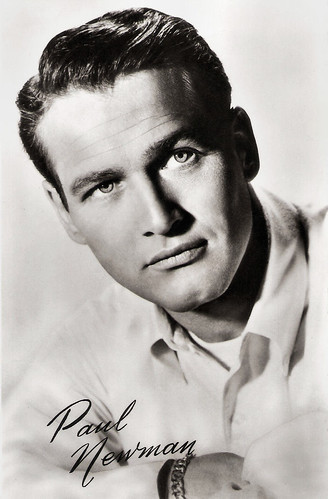
Dutch postcard by Uitg. Takken, Utrecht, no. 3265.
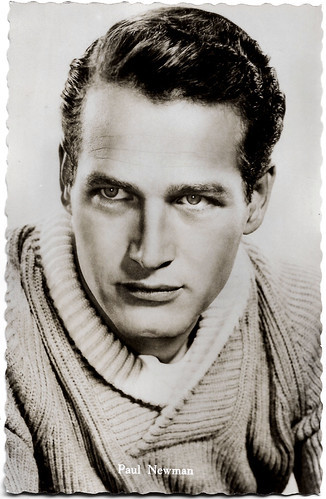
West-German postcard by Kolibri-Verlag, Minden-Westf, no. 395. Photo: M.G.M. Paul Newman in Cat on a Hot Tin Roof (Richard Brooks, 1958).
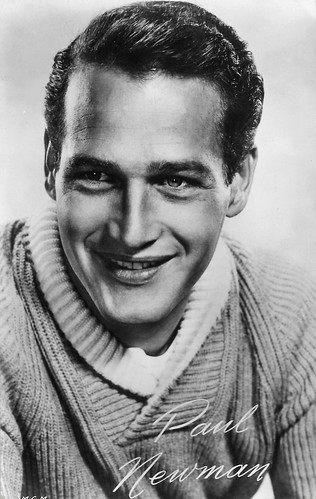
Dutch postcard by Uitg. Takken, no. AX 4464. Photo: M.G.M.
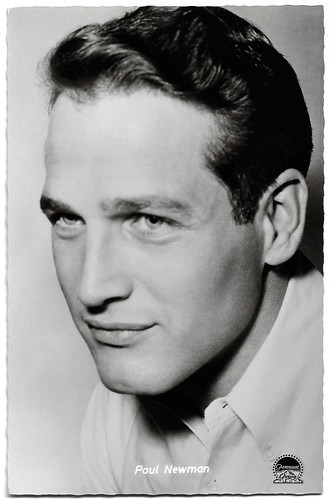
German postcard by Kolibri-Verlag G.m.b.H., Minden-Westf., no. 1716. Photo: Paramount. Paul Newman in Hud (Martin Ritt, 1963).
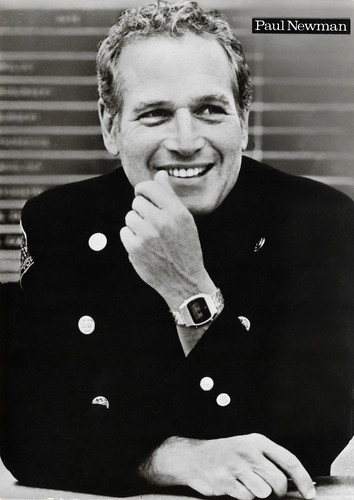
Big East-German postcard by Progress Film-Verleih, Berlin, no. 22/84. Photo: Warner Bros. Paul Newman in Fort Apache the Bronx (Daniel Petrie, 1981).
Superstar status and Oscar nominations
Paul Newman traveled back to Broadway to star in Tennessee Williams' 'Sweet Bird of Youth'. Upon his return to the West Coast, he bought himself out of his Warner Bros. contract before starring in the smash From the Terrace (Mark Robson, 1960) with Joanne Woodward. Exodus (Otto Preminger, 1960), another major hit, quickly followed.
The 1960s would bring Paul Newman into superstar status, as he became one of the most popular actors of the decade. In 1961, he played one of his most memorable roles as pool shark 'Fast' Eddie Felson in The Hustler (Robert Rossen, 1961) with Jackie Gleason and Piper Laurie . It garnered him the first of three Best Actor Oscar nominations during the decade.
The other two were for the Western Hud (Marin Ritt, 1963), and the superb chain-gang drama Cool Hand Luke (Jack Smight, 1967). He also appeared in the political thriller Torn Curtain (Alfred Hitchcock, 1966) with Julie Andrews . The film, set in the Cold War, is about an American scientist who appears to defect behind the Iron Curtain to East Germany.
Other minor hits were the mystery Harper (Jack Smight, 1966), with Lauren Bacall , and the Western Hombre (Martin Ritt, 1967), based on the novel by Elmore Leonard and co-starring Fredric March. In 1968, his debut directorial effort Rachel, Rachel (Paul Newman, 1968) was given good marks. He directed three actors to Oscar nominations: Joanne Woodward (Best Actress, Rachel, Rachel (1968)), Estelle Parsons (Best Supporting Actress, Rachel, Rachel (1968)), and Richard Jaeckel (Best Supporting Actor, Sometimes a Great Notion (1971)). Newman won a Golden Globe Award for his direction of Rachel, Rachel (1968).
1969 brought the popular screen duo of Newman and Robert Redford together for the first time when Butch Cassidy and the Sundance Kid (George Roy Hill, 1969) was released. It was a box office smash. Through the 1970s, Newman had hits and misses from such popular films The Sting (George Roy Hill, 1973) with Robert Redford, which won the 1973 Best Picture Oscar, and the star-studded disaster epic The Towering Inferno (John Guillermin, 1974), to lesser-known films as the Western The Life and Times of Judge Roy Bean (Robert Altman, 1972) with Jacqueline Bisset , to a cult classic, the sports comedy Slap Shot (George Roy Hill, 1977) with Michael Ontkean. In 1978, Newman's only son, Scott, died of a drug overdose. After Scott's death, Newman's personal life and film choices moved in a different direction.
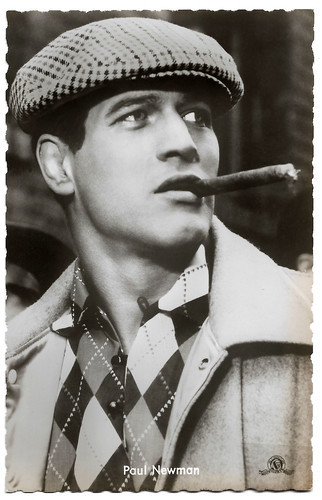
West-German postcard by Kolibri-Verlag, Minden-Westf, no. 2485. Photo: M.G.M. Paul Newman in Somebody Up There Likes Me (Robert Wise, 1956).
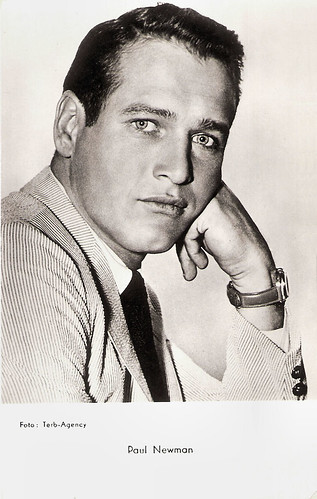
French postcard by Editions P.I., license holder for UFA, no. FK 4663. Photo: Terb-Agency.
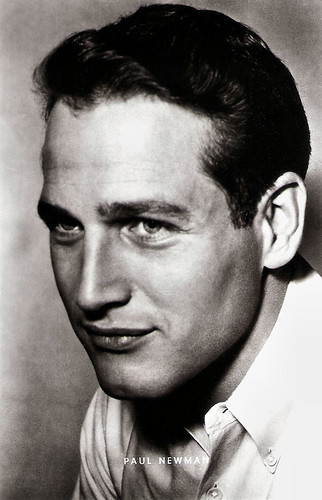
West-German postcard by Netter's Starverlag, Berlin.
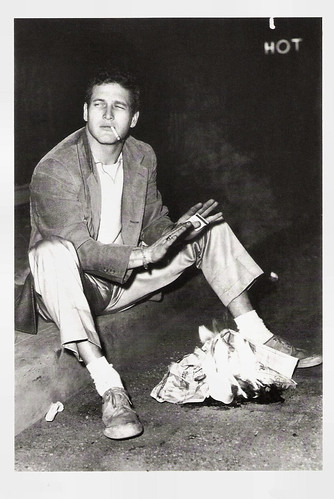
British postcard by "Snappy Pop Pics Productions", Mini Series.

Vintage postcard.
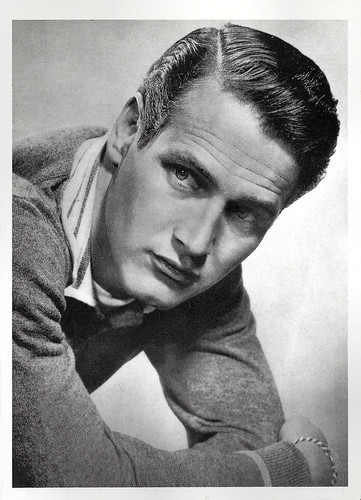
Italian postcard by Max.

Italian postcard by Max. Photo: DD&E / Peter Schroeder.
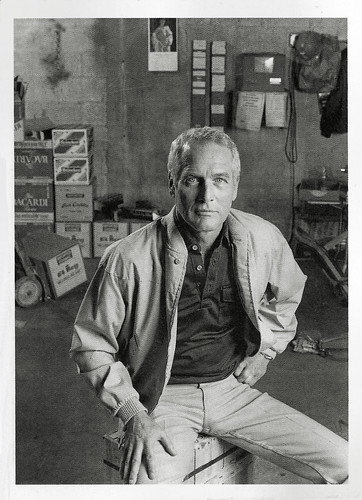
Italian postcard by Max. Photo: Tim Zimberoff.
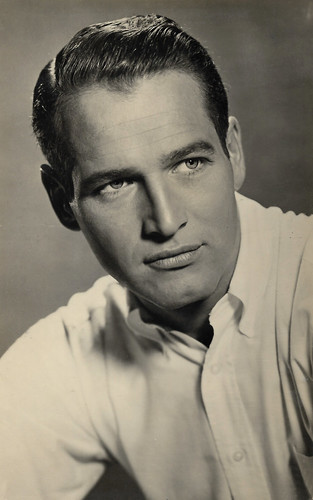
Spanish postcard by Kores, no. 7042. Photo: 20th Century Fox. Paul Newman in The Long, Hot Summer (Martin Ritt, 1958).
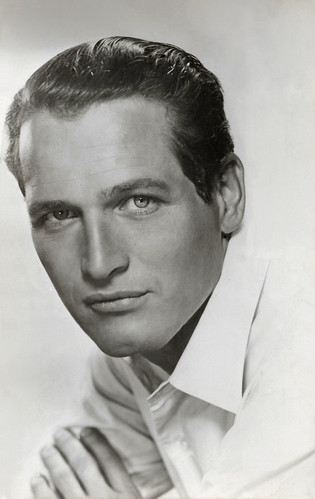
Spanish postcard by Edic. Raker, Barcelona, no. 133. Photo: Warner Bros. Paul Newman in The Young Philadelphians (Vincent Sherman, 1959).
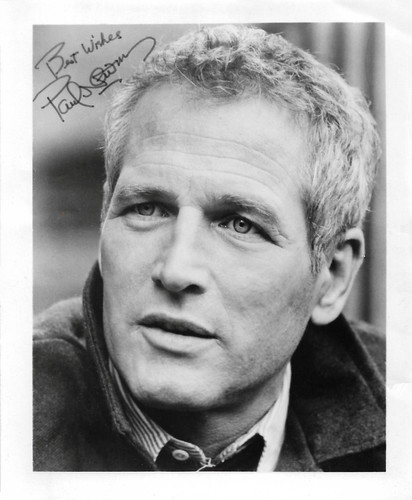
Vintage autograph card.
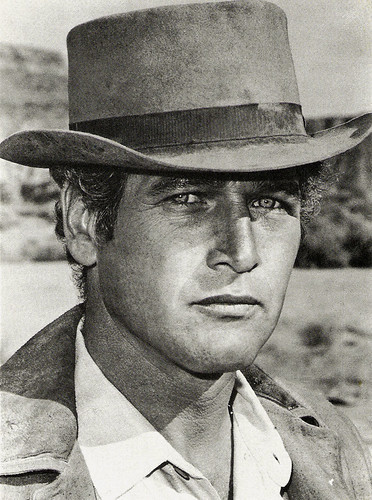
English postcard in the Athena Star Collection, London, no. 9238. Paul Newman in Butch Cassidy and the Sundance Kid (George Roy Hill, 1969).

French postcard by INPI. Photo: Robert Redford and Paul Newman in Butch Cassidy and the Sundance Kid (George Roy Hill, 1969).
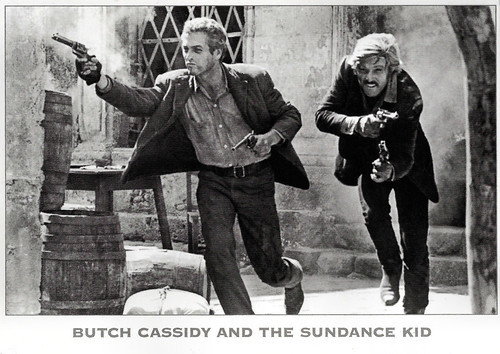
British postcard in the Film & Music Personalities series by Pyramid, Leicester, no. PC 2038. Paul Newman and Robert Redford in Butch Cassidy and the Sundance Kid (George Roy Hill, 1969).
The highest-grossing film of his career
Paul Newman's acting work in the 1980s and on is what is often most praised by critics today. He became more at ease with himself and it was evident in The Verdict (Sidney Lumet, 1982) with Charlotte Rampling , for which he received his sixth Best Actor Oscar nomination. In 1987, he finally received his first Oscar for The Color of Money (Marin Scorsese, 1986) with Tom Cruise , almost thirty years after Woodward had won hers.
Friend and director of Somebody Up There Likes Me (1956), Robert Wise accepted the award on Newman's behalf as the actor did not attend the ceremony. Previously, Newman had been nominated as the same character in The Hustler (Robert Rossen, 1961). In total, he was nominated for the Oscar nine times: Best Lead Actor for Cat on a Hot Tin Roof (Richard Brooks, 1958), The Hustler (Robert Rossen, 1961), Hud (Marin Ritt, 1963), Cool Hand Luke (Stuart Rosenberg, 1967), Absence of Malice (Sydney Pollack, 1981), The Verdict (Sidney Lumet, 1982), The Color of Money (Martin Scorsese, 1986), Nobody's Fool (Robert Benton, 1994)) and finally for Best Supporting Actor in Road to Perdition (Sam Mendes, 2002).
In 1994 Newman also played alongside Tim Robbins as the character Sidney J. Mussburger in the Coen Brothers comedy The Hudsucker Proxy. Films were not the only thing on his mind during this period. A passionate race car driver since the early 1970s (despite being color-blind), he was a co-founder of Newman-Haas racing in 1982. He also founded 'Newman's Own', a line of food products, featuring mainly spaghetti sauces and salad dressings. The company made more than $100 million in profits over the years, all of which he donated to various charities. He also started The Hole in the Wall Gang Camps, an organization for children with serious illness. He was as well known for his philanthropic ways and highly successful business ventures as he was for his legendary actor status.
Newman's marriage to Woodward lasted a half-century. Connecticut was their primary residence after leaving Hollywood and moving East in 1960. Renowned for his sense of humor, in 1998 he quipped that he was a little embarrassed to see his salad dressing grossing more than his films. During his later years, he still attended races, was much involved in his charitable organisations, and in 2006, he opened a restaurant called Dressing Room, which helps out the Westport Country Playhouse, a place in which Newman took great pride.
In 2003, Newman appeared in a Broadway revival of Thornton Wilder's 'Our Town', receiving his first Tony Award nomination for his performance. The animated Disney-Pixar comedy Cars (John Lasseter, 2006) was his final film. It was the highest-grossing film of his career. In 2007, while the public was largely unaware of the serious illness from which he was suffering, Newman made some headlines when he said he was losing his invention and confidence in his acting abilities and that acting was "pretty much a closed book for me".
A smoker for many years, Paul Newman died in 2008, aged 83, from lung cancer. With his first wife Jackie, he had three children, Scott, Stephanie, and Susan. Susan Kendall Newman is well known for stage acting and her philanthropic activities. His three daughters with Joanne Woodward are actress Melissa Newman, Nell Potts, and Claire Newman. Nine years after Paul Newman's death, he reprised his role as Doc Hudson in Cars 3 (2017): unused recordings from Cars (2006) were used as new dialogue.
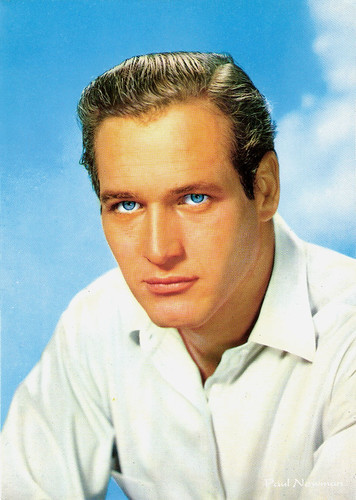
Italian postcard in the series Artisti di Sempre by Ed. Rotalfoto, Milano, no. 291.
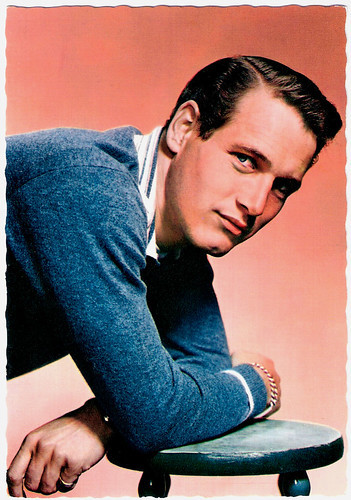
French postcard, no. 111.
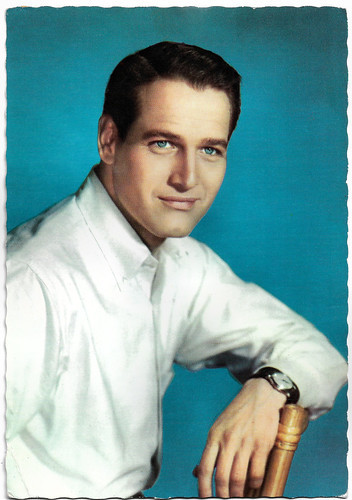
French postcard by EDUG, no. 152.
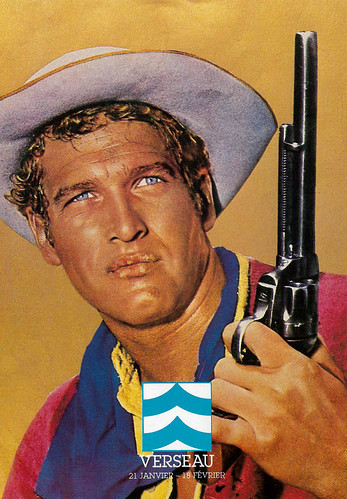
French postcard by Editions F. Nugeron in the Signes du zodiaque series, no. 2, Paul Newman - Verseau (Aquarius). Paul Newman in The Left Handed Gun (Arthur Penn, 1958).
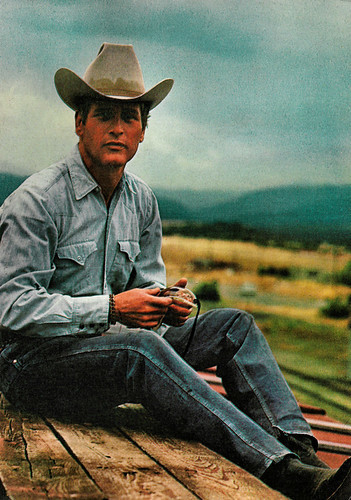
Italian postcard by Edizioni Beatrice D'Esti, no. 20161. Paul Newman in Hud (Martin Ritt, 1963).
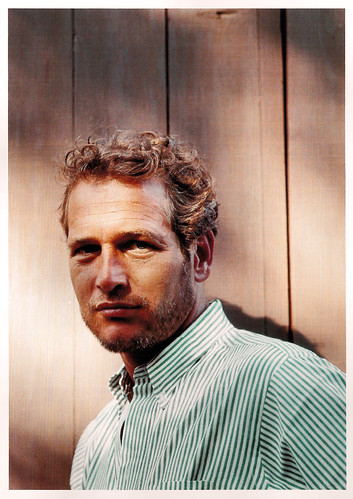
American postcard by Fotofolio, no. 2868. Photo: Milton H. Greene. Caption: Paul Newman, Connecticut, 1964.
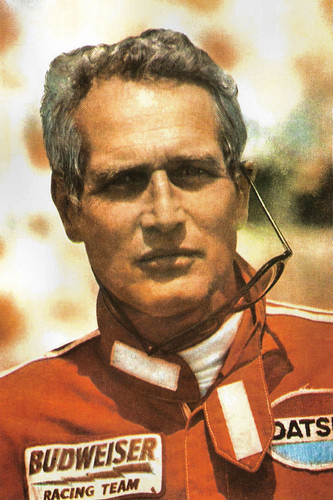
Romanian postcard by Casa Filmului Acin, no. C.P.V.S. c-sa 53066.
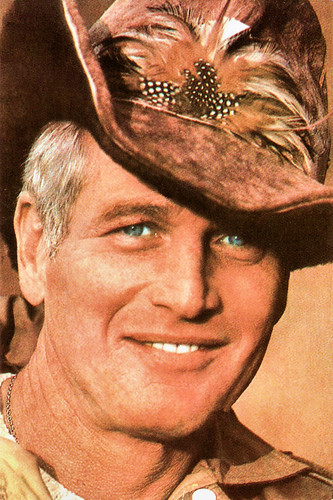
Romanian postcard by Casa Filmului Acin.
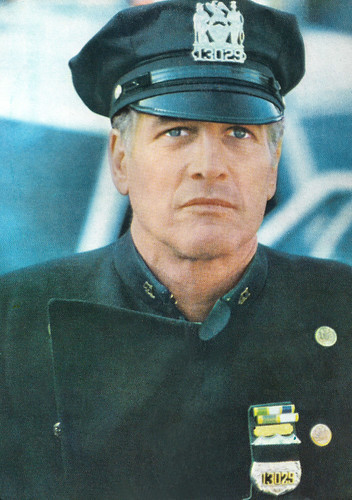
Romanian postcard by Casa Filmului Acin. Paul Newman in Fort Apache the Bronx (Daniel Petrie, 1981).
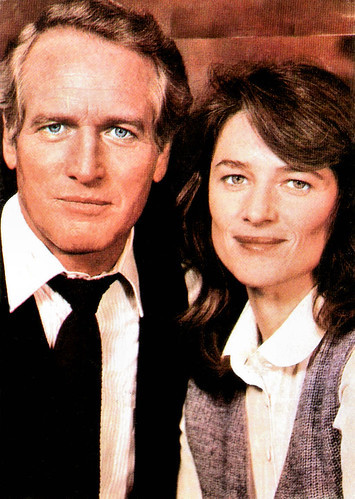
Romanian postcard by Casa Filmului Acin, no. 43079. Photo: Charlotte Rampling and Paul Newman in The Verdict (Sidney Lumet, 1982).
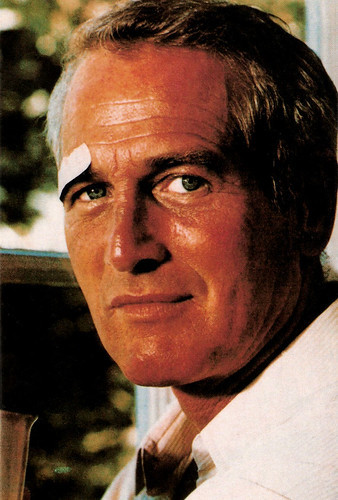
British postcard by Superior, no. PC 9.
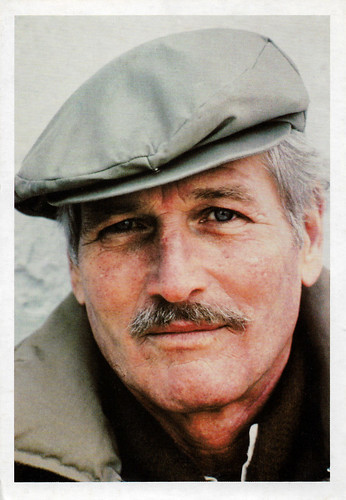
French postcard by Editions Humour à la Carte, Paris, no. ST-118.
Sources: (IMDb), Jason Ankeny (AllMovie), AllMovie, Wikipedia, and .

German postcard by Krüger, no. 902/261.

Italian postcard by Bromofoto, Milano, no. 1412. Photo: Warner Bros.

Spanish postcard by Archivo Bermejo, no. C.6., 1963 Photo: Paramount / Filmax. Photo: Paul Newman in Hud (Martin Ritt, 1963).

West-German Kolibri postcard by Friedrich W. Sander-Verlag, Minden/Westf., no. 2863. Photo: Warner Bros. Paul Newman in Harper (Jack Smight, 1966).

Italian postcard by Edizioni Beatrice D'Este, no. 20020. Sent by mail in 1984.

American postcard by Fan Club Post Cards, New York, N.Y., no. PC 22. Paul Newman and Robert Redford in Butch Cassidy and the Sundance Kid (George Roy Hill, 1969).
The much admired and popular New York Actors Studio
Paul Leonard Newman was born in 1925, in Shaker Heights, Ohio, a suburb of Cleveland. He was the second son of Arthur Sigmund Newman and Theresa Fetsko. His father was a Jewish businessman who owned a successful sporting goods store. His mother was a practicing Christian Scientist with an interest in the creative arts, and it rubbed off on her son.
At age 10, he performed in a stage production of 'Saint George and the Dragon' at the Cleveland Play House. He also acted in high school plays.
By 1950, the 25-year-old Newman had been kicked out of Ohio University, where he belonged to the Phi Kappa Tau fraternity, for unruly behavior (denting the college president's car with a beer keg), served three years in the United States Navy during World War II as a radio operator, graduated from Ohio's Kenyon College, married his first wife, actress Jacqueline 'Jackie' Witte, and had his first child, Scott.
That same year, his father died. When he became successful in later years, Newman said if he had any regrets it would be that his father was not around to witness his success. He brought Jackie back to Shaker Heights and he ran his father's store for a short period.
Then, knowing that wasn't the career path he wanted to take, he sold his interest in the store to his brother and moved with Jackie and Scott to New Haven, Connecticut. There he attended Yale University's School of Drama. While doing a play there, Newman was spotted by two agents, who invited him to come to New York City to pursue a career as a professional actor.
After moving to New York, he acted in guest spots for various television series, and in 1953 came a big break. He got the part of understudy of the lead role in the successful Broadway play 'Picnic' by William Inge. Through this play, he met actress Joanne Woodward, who was also an understudy in the play. While they got on very well and there was a strong attraction, Newman was married and his second child, Susan, was born that year.
During this time, Newman was accepted into the much admired and popular New York Actors Studio, although he did not actually audition. In 1954, a film Newman was very reluctant to do was released, the failed costume drama The Silver Chalice (Victor Saville, 1954). He considered his performance in this costume epic to be so bad that he took out a full-page ad in Variety apologising for it to anyone who might have seen it. He immediately wanted to return to the stage, and performed in 'The Desperate Hours'.
In 1956, he got the chance to redeem himself in the film world by portraying boxer Rocky Graziano in Somebody Up There Likes Me (Robert Wise, 1956) with Pier Angeli . The role of Rocky was originally awarded to James Dean , who died before filming began. Critics praised Newman's performance.
Dean also was signed to play Billy the Kid in The Left Handed Gun (Arthur Penn, 1958), but that role was also inherited by Newman after Dean's death. With a handful of films to his credit, he was cast in The Long, Hot Summer (1958), an acclaimed adaptation of a pair of William Faulkner short stories. His co-star was Joanne Woodward.
During the shooting of this film, they realised they were meant to be together and by now, so did his then-wife Jackie, who gave Newman a divorce. He and Woodward wed in Las Vegas in January 1958. They went on to have three daughters together. They raised them in Westport, Connecticut. In 1959, Newman received his first Academy Award nomination for Best Actor, in Cat on a Hot Tin Roof (Richard Brooks, 1958), based on the Pulitzer Prize-winning play by Tennessee Williams. Well-received by both critics and audiences, Cat on Hot Tin Roof was MGM's most successful release of 1958 and became the third highest-grossing film of that year.

French postcard by Editions P.I., Paris, offered by Les Carbones Korès 'Carboplane', no. 945. Photo: 20th Century Fox.

Belgian postcard, no. 5451.

Dutch postcard by Uitg. Takken, Utrecht, no. 3265.

West-German postcard by Kolibri-Verlag, Minden-Westf, no. 395. Photo: M.G.M. Paul Newman in Cat on a Hot Tin Roof (Richard Brooks, 1958).

Dutch postcard by Uitg. Takken, no. AX 4464. Photo: M.G.M.

German postcard by Kolibri-Verlag G.m.b.H., Minden-Westf., no. 1716. Photo: Paramount. Paul Newman in Hud (Martin Ritt, 1963).

Big East-German postcard by Progress Film-Verleih, Berlin, no. 22/84. Photo: Warner Bros. Paul Newman in Fort Apache the Bronx (Daniel Petrie, 1981).
Superstar status and Oscar nominations
Paul Newman traveled back to Broadway to star in Tennessee Williams' 'Sweet Bird of Youth'. Upon his return to the West Coast, he bought himself out of his Warner Bros. contract before starring in the smash From the Terrace (Mark Robson, 1960) with Joanne Woodward. Exodus (Otto Preminger, 1960), another major hit, quickly followed.
The 1960s would bring Paul Newman into superstar status, as he became one of the most popular actors of the decade. In 1961, he played one of his most memorable roles as pool shark 'Fast' Eddie Felson in The Hustler (Robert Rossen, 1961) with Jackie Gleason and Piper Laurie . It garnered him the first of three Best Actor Oscar nominations during the decade.
The other two were for the Western Hud (Marin Ritt, 1963), and the superb chain-gang drama Cool Hand Luke (Jack Smight, 1967). He also appeared in the political thriller Torn Curtain (Alfred Hitchcock, 1966) with Julie Andrews . The film, set in the Cold War, is about an American scientist who appears to defect behind the Iron Curtain to East Germany.
Other minor hits were the mystery Harper (Jack Smight, 1966), with Lauren Bacall , and the Western Hombre (Martin Ritt, 1967), based on the novel by Elmore Leonard and co-starring Fredric March. In 1968, his debut directorial effort Rachel, Rachel (Paul Newman, 1968) was given good marks. He directed three actors to Oscar nominations: Joanne Woodward (Best Actress, Rachel, Rachel (1968)), Estelle Parsons (Best Supporting Actress, Rachel, Rachel (1968)), and Richard Jaeckel (Best Supporting Actor, Sometimes a Great Notion (1971)). Newman won a Golden Globe Award for his direction of Rachel, Rachel (1968).
1969 brought the popular screen duo of Newman and Robert Redford together for the first time when Butch Cassidy and the Sundance Kid (George Roy Hill, 1969) was released. It was a box office smash. Through the 1970s, Newman had hits and misses from such popular films The Sting (George Roy Hill, 1973) with Robert Redford, which won the 1973 Best Picture Oscar, and the star-studded disaster epic The Towering Inferno (John Guillermin, 1974), to lesser-known films as the Western The Life and Times of Judge Roy Bean (Robert Altman, 1972) with Jacqueline Bisset , to a cult classic, the sports comedy Slap Shot (George Roy Hill, 1977) with Michael Ontkean. In 1978, Newman's only son, Scott, died of a drug overdose. After Scott's death, Newman's personal life and film choices moved in a different direction.

West-German postcard by Kolibri-Verlag, Minden-Westf, no. 2485. Photo: M.G.M. Paul Newman in Somebody Up There Likes Me (Robert Wise, 1956).

French postcard by Editions P.I., license holder for UFA, no. FK 4663. Photo: Terb-Agency.

West-German postcard by Netter's Starverlag, Berlin.

British postcard by "Snappy Pop Pics Productions", Mini Series.

Vintage postcard.

Italian postcard by Max.

Italian postcard by Max. Photo: DD&E / Peter Schroeder.

Italian postcard by Max. Photo: Tim Zimberoff.

Spanish postcard by Kores, no. 7042. Photo: 20th Century Fox. Paul Newman in The Long, Hot Summer (Martin Ritt, 1958).

Spanish postcard by Edic. Raker, Barcelona, no. 133. Photo: Warner Bros. Paul Newman in The Young Philadelphians (Vincent Sherman, 1959).

Vintage autograph card.

English postcard in the Athena Star Collection, London, no. 9238. Paul Newman in Butch Cassidy and the Sundance Kid (George Roy Hill, 1969).

French postcard by INPI. Photo: Robert Redford and Paul Newman in Butch Cassidy and the Sundance Kid (George Roy Hill, 1969).

British postcard in the Film & Music Personalities series by Pyramid, Leicester, no. PC 2038. Paul Newman and Robert Redford in Butch Cassidy and the Sundance Kid (George Roy Hill, 1969).
The highest-grossing film of his career
Paul Newman's acting work in the 1980s and on is what is often most praised by critics today. He became more at ease with himself and it was evident in The Verdict (Sidney Lumet, 1982) with Charlotte Rampling , for which he received his sixth Best Actor Oscar nomination. In 1987, he finally received his first Oscar for The Color of Money (Marin Scorsese, 1986) with Tom Cruise , almost thirty years after Woodward had won hers.
Friend and director of Somebody Up There Likes Me (1956), Robert Wise accepted the award on Newman's behalf as the actor did not attend the ceremony. Previously, Newman had been nominated as the same character in The Hustler (Robert Rossen, 1961). In total, he was nominated for the Oscar nine times: Best Lead Actor for Cat on a Hot Tin Roof (Richard Brooks, 1958), The Hustler (Robert Rossen, 1961), Hud (Marin Ritt, 1963), Cool Hand Luke (Stuart Rosenberg, 1967), Absence of Malice (Sydney Pollack, 1981), The Verdict (Sidney Lumet, 1982), The Color of Money (Martin Scorsese, 1986), Nobody's Fool (Robert Benton, 1994)) and finally for Best Supporting Actor in Road to Perdition (Sam Mendes, 2002).
In 1994 Newman also played alongside Tim Robbins as the character Sidney J. Mussburger in the Coen Brothers comedy The Hudsucker Proxy. Films were not the only thing on his mind during this period. A passionate race car driver since the early 1970s (despite being color-blind), he was a co-founder of Newman-Haas racing in 1982. He also founded 'Newman's Own', a line of food products, featuring mainly spaghetti sauces and salad dressings. The company made more than $100 million in profits over the years, all of which he donated to various charities. He also started The Hole in the Wall Gang Camps, an organization for children with serious illness. He was as well known for his philanthropic ways and highly successful business ventures as he was for his legendary actor status.
Newman's marriage to Woodward lasted a half-century. Connecticut was their primary residence after leaving Hollywood and moving East in 1960. Renowned for his sense of humor, in 1998 he quipped that he was a little embarrassed to see his salad dressing grossing more than his films. During his later years, he still attended races, was much involved in his charitable organisations, and in 2006, he opened a restaurant called Dressing Room, which helps out the Westport Country Playhouse, a place in which Newman took great pride.
In 2003, Newman appeared in a Broadway revival of Thornton Wilder's 'Our Town', receiving his first Tony Award nomination for his performance. The animated Disney-Pixar comedy Cars (John Lasseter, 2006) was his final film. It was the highest-grossing film of his career. In 2007, while the public was largely unaware of the serious illness from which he was suffering, Newman made some headlines when he said he was losing his invention and confidence in his acting abilities and that acting was "pretty much a closed book for me".
A smoker for many years, Paul Newman died in 2008, aged 83, from lung cancer. With his first wife Jackie, he had three children, Scott, Stephanie, and Susan. Susan Kendall Newman is well known for stage acting and her philanthropic activities. His three daughters with Joanne Woodward are actress Melissa Newman, Nell Potts, and Claire Newman. Nine years after Paul Newman's death, he reprised his role as Doc Hudson in Cars 3 (2017): unused recordings from Cars (2006) were used as new dialogue.

Italian postcard in the series Artisti di Sempre by Ed. Rotalfoto, Milano, no. 291.

French postcard, no. 111.

French postcard by EDUG, no. 152.

French postcard by Editions F. Nugeron in the Signes du zodiaque series, no. 2, Paul Newman - Verseau (Aquarius). Paul Newman in The Left Handed Gun (Arthur Penn, 1958).

Italian postcard by Edizioni Beatrice D'Esti, no. 20161. Paul Newman in Hud (Martin Ritt, 1963).

American postcard by Fotofolio, no. 2868. Photo: Milton H. Greene. Caption: Paul Newman, Connecticut, 1964.

Romanian postcard by Casa Filmului Acin, no. C.P.V.S. c-sa 53066.

Romanian postcard by Casa Filmului Acin.

Romanian postcard by Casa Filmului Acin. Paul Newman in Fort Apache the Bronx (Daniel Petrie, 1981).

Romanian postcard by Casa Filmului Acin, no. 43079. Photo: Charlotte Rampling and Paul Newman in The Verdict (Sidney Lumet, 1982).

British postcard by Superior, no. PC 9.

French postcard by Editions Humour à la Carte, Paris, no. ST-118.
Sources: (IMDb), Jason Ankeny (AllMovie), AllMovie, Wikipedia, and .
Published on May 27, 2021 22:00
May 26, 2021
Three films starring Pina Menichelli
Fascinating and enigmatic Pina Menichelli (1890-1984) was the most bizarre diva of the Italian silent film. Ivo selected Italian postcards of three films which she made in 1923, at the end of her film career: L'ospite sconosciuta/The Unknown Guest (Telemaco Ruggeri, 1923), the comedy La dama de Chez Maxim's (Amleto Palermi, 1923), and La donna e l'uomo (Amleto Palermi, 1923).
L'ospite sconosciuta (1923)

Italian postcard by G.B. Falci, Milano. Photo: Fotominio. Pina Menichelli and Giovanni Grasso in Malafemmina, a title unknown to IMDb , but it is the alternative title of L' ospite sconosciuta/The Unknown Guest (Telemaco Ruggeri, 1923).
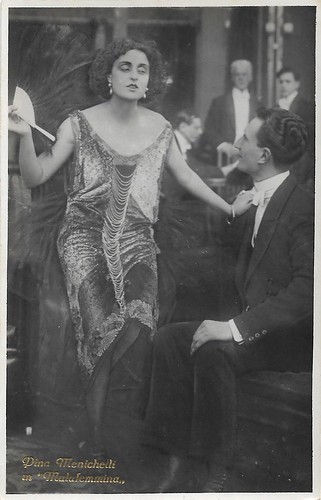
Italian postcard by G.B. Falci, Milano, no. 182. Pina Menichelli and Andrea Conigliaro in Malafemmina a.k.a. L'ospite sconosciuta/The Unknown Guest (Telemaco Ruggeri, 1923).
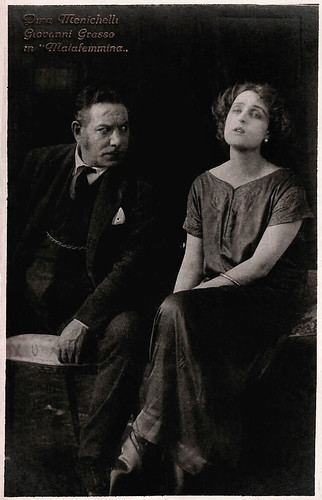
Italian postcard by G.B. Falci, Milano, no. 189. Pina Menichelli and Giovanni Grasso in Malafemmina a.k.a. L'ospite sconosciuta/The Unknown Guest (Telemaco Ruggeri, 1923).
L' ospite sconosciuta/The Unknown Guest (Telemaco Ruggeri, 1923) was written by future director Amleto Palermi. Pietro, a young provincial (Andrea Conigliaro) falls into the clutches of Stasia, a mundane adventuress (Menichelli), and spends his father's money on her. Di Scenta, the father (Giovanni Grasso), pushes the woman to convince the son she never loved him and enforces this by having his son discovering the two of them in a restaurant. The son shoots the woman, while the father takes the blame.
The Italian censorship was so heavy in its cuts that the film became incomprehensible to Italian audiences. Italian critics didn't like it, therefore. The censor didn't allow the representation nor even the suggestion that the son thinks he has to compete with his father in the love for Stasia. So all the scenes in which the father pretends his love for the woman in order to save his son were cut, as well as intertitles explaining this situation.

Italian postcard by G.B. Falci, Milano, no. 241. Pina Menichelli and Giovanni Grasso in Malafemmina a.k.a. L' ospite sconosciuta/The Unknown Guest (Telemaco Ruggeri, 1923).

Italian postcard by Vettori, Bologna, no. 402. Pina Menichelli and Giovanni Grasso in L' ospite sconosciuta/The Unknown Guest (Telemaco Ruggeri, 1923).
La dama de Chez Maxim's (1923)
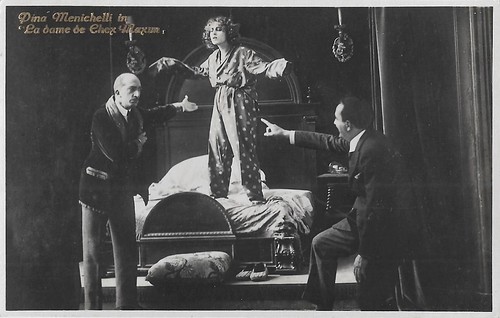
Italian postcard by G.B. Falci, Milano, no. 253. Pina Menichelli and Marcel Lévesque in La dama de Chez Maxim's (Amleto Palermi, 1923). Menichelli played the legendary Môme Crevette in one of the many film adaptations of Georges Feydeau's classic boulevard comedy.

Italian postcard by G.B. Falci, Milano. Pina Menichelli in La dama de Chez Maxim's (Amleto Palermi, 1923). The man may be Alfredo Menichelli, Menichelli's younger brother, who plays the young duke.
With La dama de Chez Maxim's (Amleto Palermi, 1923) and with Occupati d'Amelia (Telemaco Ruggeri, 1925), another Georges Feydeau adaptation, Menichelli proved she was well able to do comedy and not only melodramatic and 'vampy' films. In both films, one of her co-stars was the French comedian Marcel Lévesque . The films were well received.
From 1920 Menichelli, after her years at Itala, moved to Rinascimento Film, founded in 1918 and run by producer Baron Carlo D'Amato, with whom she would have a long relationship before marrying him in 1930. Rinascimento Film produced several films with Menichelli in the early 1920s including Il romanzo di un giovane povero, La seconda moglie, Malafemmina, La donna e l'uomo, and La dama de Chez Maxim's. In 1924 Menichelli withdrew from cinema and held back any attempt to interview her.

Italian postcard by G.B. Falci, Milano. Pina Menichelli in La dama de Chez Maxim's (Amleto Palermi, 1923).
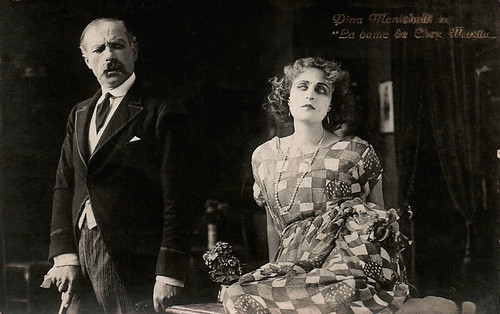
Italian postcard by G.B. Falci, Milano, no. 82. Photo: La Fotominio. Pina Menichelli in La dame de Chez Maxim's (Amleto Palermi 1923). Here also with Ugo Gracci as Petypon.
La donna e l'uomo (1923)
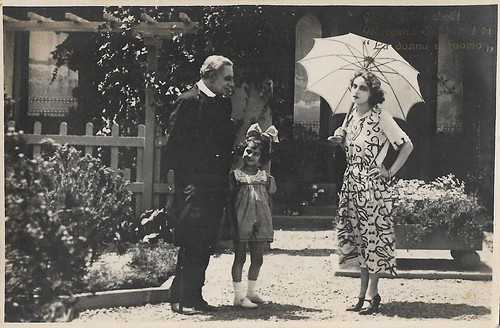
Italian postcard by G.B. Falci, Milano, no. 118. Photo: La Fotominio. Pina Menichelli and Marcella Sabbatini in the drama La donna e l'uomo (Amleto Palermi, 1923). The film was produced by Rinascimento Film and distributed by UCI.
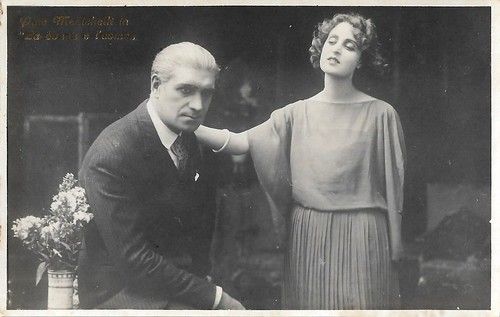
Italian postcard by G.B. Falci, Milano, no. 180. Photo: Fotominio. Pina Menichelli and Alfredo Bertone in La donna e l'uomo (Amleto Palermi, 1923). The film was produced by Rinascimento Film and distributed by UCI.
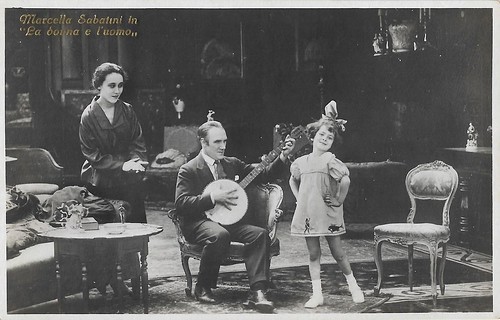
Italian postcard by Ed. G.B. Falci, Milano. Postcard for the 1923 Italian silent film La donna e l'uomo, directed by Amleto Palermi, produced by Rinascimento Film and distributed by UCI. Star of the film was the Italian diva Pina Menichelli, but the card shows Milton Rosmer and Marcella Sabbatini. The woman is unknown.
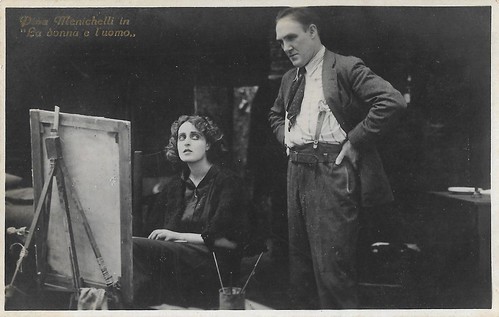
Italian postcard by G.B. Falci, Milano, no. 223. Pina Menichelli and Milton Rosmer in La donna e l'uomo (Amleto Palermi, 1923).
In La donna e l'uomo (Amleto Palermi, 1923), young Gilian (Menichelli) has married the egoist and unworthy Philip O'Mara (Milton Rosmer), who after having reduced her to misery, abandons her and her daughter, little Dora (Marcella Sabbatini), and leaves for Australia. When the woman meets a rich baron who offers help and asks her to marry him ( Livio Pavanelli ), Philip returns and starts to persecute his wife with letters, asking for money. While Gillian is vexed and on the verge of paying him, he is killed by a guy whom he had cheated on. Liberated from her nightmare Gilian can start a new life.
The film La donna e l'uomo was partly shot in the UK. The British actor and director Milton Rosmer (1881-1971) got in exchange for his contribution a distribution contract by UCI for his own film The Diamond Necklace (1921). Instead of her usual femme fatale parts, Pina Menichelli here played a tormented, simple woman, brutally treated by her husband. She was praised in the Italian and British press for her emotional, sincere performance. La rivista cinematografica indicated the film as 'naked realism', though treated with poetry. As far as known, La donna e l'uomo is a lost film.

Italian postcard by G.B. Falci, Milano. Photo: Fotominio. Pina Menichelli in La donna e l'uomo (Amleto Palermi, 1923).
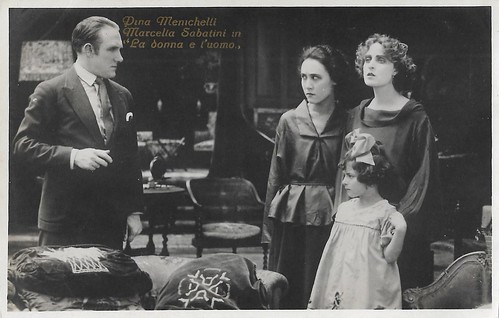
Italian postcard by G.B. Falci, Milano. Photo: Fotominio. Pina Menichelli , Milton Rosmer and Marcella Sabbatini in La donna e l'uomo (Amleto Palermi, 1923).
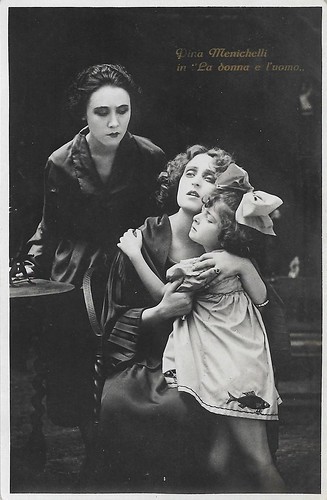
Italian postcard by G.B. Falci, Milano. Photo: Fotominio. Pina Menichelli and Marcella Sabbatini in La donna e l'uomo (Amleto Palermi, 1923).
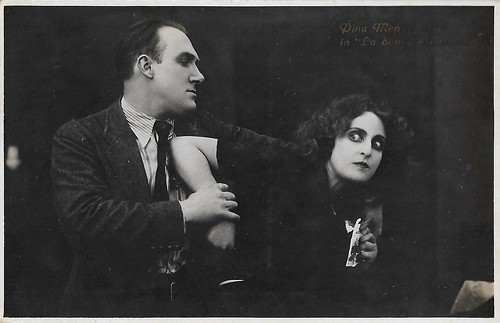
Italian postcard by Ed. G.B. Falci, Milano. Pina Menichelli and Milton Rosmer in La donna e l'uomo (Amleto Palermi, 1923), produced by Rinascimento Film and distributed by UCI.
Sources: Vittorio Martinelli (Il cinema muto italiano, 1923-1931), and IMDb.
L'ospite sconosciuta (1923)

Italian postcard by G.B. Falci, Milano. Photo: Fotominio. Pina Menichelli and Giovanni Grasso in Malafemmina, a title unknown to IMDb , but it is the alternative title of L' ospite sconosciuta/The Unknown Guest (Telemaco Ruggeri, 1923).

Italian postcard by G.B. Falci, Milano, no. 182. Pina Menichelli and Andrea Conigliaro in Malafemmina a.k.a. L'ospite sconosciuta/The Unknown Guest (Telemaco Ruggeri, 1923).

Italian postcard by G.B. Falci, Milano, no. 189. Pina Menichelli and Giovanni Grasso in Malafemmina a.k.a. L'ospite sconosciuta/The Unknown Guest (Telemaco Ruggeri, 1923).
L' ospite sconosciuta/The Unknown Guest (Telemaco Ruggeri, 1923) was written by future director Amleto Palermi. Pietro, a young provincial (Andrea Conigliaro) falls into the clutches of Stasia, a mundane adventuress (Menichelli), and spends his father's money on her. Di Scenta, the father (Giovanni Grasso), pushes the woman to convince the son she never loved him and enforces this by having his son discovering the two of them in a restaurant. The son shoots the woman, while the father takes the blame.
The Italian censorship was so heavy in its cuts that the film became incomprehensible to Italian audiences. Italian critics didn't like it, therefore. The censor didn't allow the representation nor even the suggestion that the son thinks he has to compete with his father in the love for Stasia. So all the scenes in which the father pretends his love for the woman in order to save his son were cut, as well as intertitles explaining this situation.

Italian postcard by G.B. Falci, Milano, no. 241. Pina Menichelli and Giovanni Grasso in Malafemmina a.k.a. L' ospite sconosciuta/The Unknown Guest (Telemaco Ruggeri, 1923).

Italian postcard by Vettori, Bologna, no. 402. Pina Menichelli and Giovanni Grasso in L' ospite sconosciuta/The Unknown Guest (Telemaco Ruggeri, 1923).
La dama de Chez Maxim's (1923)

Italian postcard by G.B. Falci, Milano, no. 253. Pina Menichelli and Marcel Lévesque in La dama de Chez Maxim's (Amleto Palermi, 1923). Menichelli played the legendary Môme Crevette in one of the many film adaptations of Georges Feydeau's classic boulevard comedy.

Italian postcard by G.B. Falci, Milano. Pina Menichelli in La dama de Chez Maxim's (Amleto Palermi, 1923). The man may be Alfredo Menichelli, Menichelli's younger brother, who plays the young duke.
With La dama de Chez Maxim's (Amleto Palermi, 1923) and with Occupati d'Amelia (Telemaco Ruggeri, 1925), another Georges Feydeau adaptation, Menichelli proved she was well able to do comedy and not only melodramatic and 'vampy' films. In both films, one of her co-stars was the French comedian Marcel Lévesque . The films were well received.
From 1920 Menichelli, after her years at Itala, moved to Rinascimento Film, founded in 1918 and run by producer Baron Carlo D'Amato, with whom she would have a long relationship before marrying him in 1930. Rinascimento Film produced several films with Menichelli in the early 1920s including Il romanzo di un giovane povero, La seconda moglie, Malafemmina, La donna e l'uomo, and La dama de Chez Maxim's. In 1924 Menichelli withdrew from cinema and held back any attempt to interview her.

Italian postcard by G.B. Falci, Milano. Pina Menichelli in La dama de Chez Maxim's (Amleto Palermi, 1923).

Italian postcard by G.B. Falci, Milano, no. 82. Photo: La Fotominio. Pina Menichelli in La dame de Chez Maxim's (Amleto Palermi 1923). Here also with Ugo Gracci as Petypon.
La donna e l'uomo (1923)

Italian postcard by G.B. Falci, Milano, no. 118. Photo: La Fotominio. Pina Menichelli and Marcella Sabbatini in the drama La donna e l'uomo (Amleto Palermi, 1923). The film was produced by Rinascimento Film and distributed by UCI.

Italian postcard by G.B. Falci, Milano, no. 180. Photo: Fotominio. Pina Menichelli and Alfredo Bertone in La donna e l'uomo (Amleto Palermi, 1923). The film was produced by Rinascimento Film and distributed by UCI.

Italian postcard by Ed. G.B. Falci, Milano. Postcard for the 1923 Italian silent film La donna e l'uomo, directed by Amleto Palermi, produced by Rinascimento Film and distributed by UCI. Star of the film was the Italian diva Pina Menichelli, but the card shows Milton Rosmer and Marcella Sabbatini. The woman is unknown.

Italian postcard by G.B. Falci, Milano, no. 223. Pina Menichelli and Milton Rosmer in La donna e l'uomo (Amleto Palermi, 1923).
In La donna e l'uomo (Amleto Palermi, 1923), young Gilian (Menichelli) has married the egoist and unworthy Philip O'Mara (Milton Rosmer), who after having reduced her to misery, abandons her and her daughter, little Dora (Marcella Sabbatini), and leaves for Australia. When the woman meets a rich baron who offers help and asks her to marry him ( Livio Pavanelli ), Philip returns and starts to persecute his wife with letters, asking for money. While Gillian is vexed and on the verge of paying him, he is killed by a guy whom he had cheated on. Liberated from her nightmare Gilian can start a new life.
The film La donna e l'uomo was partly shot in the UK. The British actor and director Milton Rosmer (1881-1971) got in exchange for his contribution a distribution contract by UCI for his own film The Diamond Necklace (1921). Instead of her usual femme fatale parts, Pina Menichelli here played a tormented, simple woman, brutally treated by her husband. She was praised in the Italian and British press for her emotional, sincere performance. La rivista cinematografica indicated the film as 'naked realism', though treated with poetry. As far as known, La donna e l'uomo is a lost film.

Italian postcard by G.B. Falci, Milano. Photo: Fotominio. Pina Menichelli in La donna e l'uomo (Amleto Palermi, 1923).

Italian postcard by G.B. Falci, Milano. Photo: Fotominio. Pina Menichelli , Milton Rosmer and Marcella Sabbatini in La donna e l'uomo (Amleto Palermi, 1923).

Italian postcard by G.B. Falci, Milano. Photo: Fotominio. Pina Menichelli and Marcella Sabbatini in La donna e l'uomo (Amleto Palermi, 1923).

Italian postcard by Ed. G.B. Falci, Milano. Pina Menichelli and Milton Rosmer in La donna e l'uomo (Amleto Palermi, 1923), produced by Rinascimento Film and distributed by UCI.
Sources: Vittorio Martinelli (Il cinema muto italiano, 1923-1931), and IMDb.
Published on May 26, 2021 22:00
May 25, 2021
Fredric March
Fredric March (1897-1975) played for a few years in stock, and, when talkies came in 1928, he was offered a part in The Dummy (Robert Milton, 1929). His performances grew steadily in dramatic appeal, and with his send-up of John Barrymore in The Royal Family of Broadway (George Cukor, Cyril Gardner, 1930), he became a star. He won the Oscar for Best Actor twice: for Dr. Jekyll and Mr. Hyde (Rouben Mamoulian, 1931) and The Best Years of Our Lives (William Wyler, 1946).
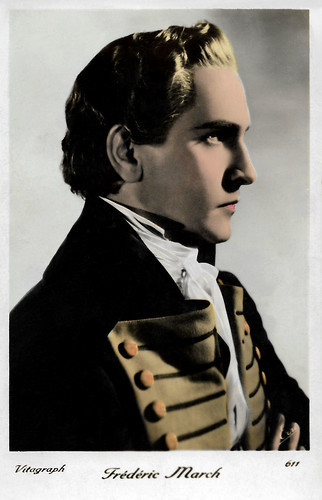
French postcard by Erpé, no. 611. Photo: Vitagraph. Fredric March in Anthony Adverse (Mervyn LeRoy, Michael Curtiz, 1936).
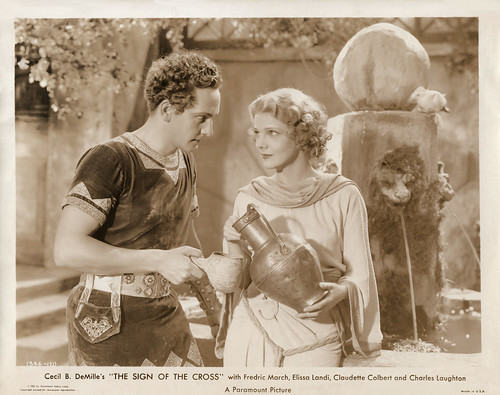
American film still by Paramount, no. 1394-120. Fredric March and Elissa Landi in The Sign of the Cross (Cecil B. DeMille, 1932).
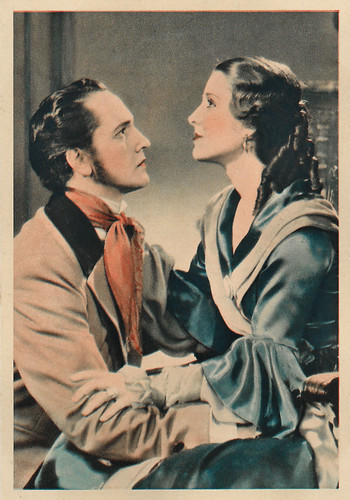
British postcard by Abdulla Cigarettes, no. 27. Photo: M.G.M. Fredric March and Norma Shearer in The Barretts of Wimpole Street (Sidney Franklin, 1934).
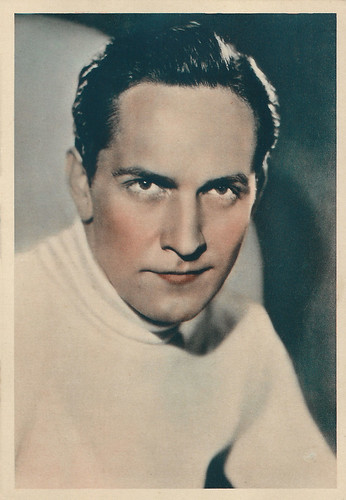
British postcard by De Reszke Cigarettes, no. 17.
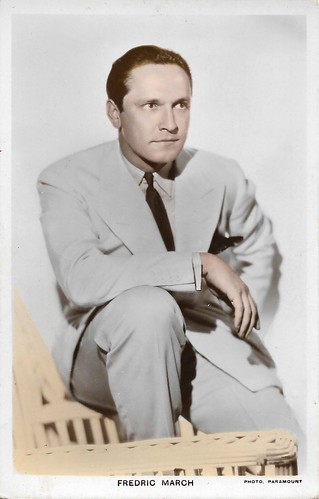
British postcard in the Colourgraph Series, no. C175. Photo: Paramount.
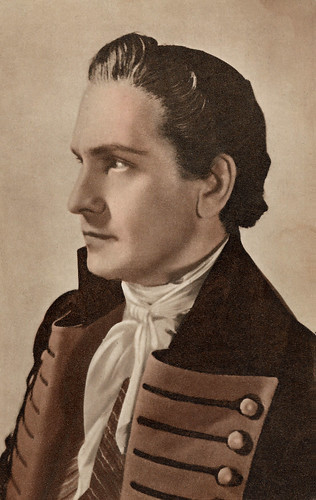
British postcard in the Real Photogravure Portrait series. Photo: Fredric March in Anthony Adverse (Mervyn LeRoy, 1936).
A rare protean quality to his acting
Fredric March was born Ernest Frederick McIntyre Bickel in 1897 in Racine, Wisconsin, USA. He was the son of Cora Brown Marcher, a schoolteacher from England, and John F. Bickel, a devout Presbyterian Church elder who worked in the wholesale hardware business. March attended the Winslow Elementary School, Racine High School, and the University of Wisconsin–Madison.
He served in the United States Army during World War I as an artillery lieutenant. After the war, he began a career in banking but in 1920 found himself cast as an extra in films being produced in New York. In 1924, he shortened Frederick to Fredric, shortened his mother's maiden name from Marcher to March, and his stage name was born.
Fredric March starred on the Broadway stage first in 1926 and would return there between screen appearances later on. He won plaudits and an Academy Award nomination for his send-up of John Barrymore in The Royal Family of Broadway (George Cukor, Cyril Gardner, 1930) opposite Ina Claire.
March would win the Oscar for Best Actor for Dr. Jekyll and Mr. Hyde (Rouben Mamoulian, 1931) and three more Academy Award nominations would come his way. Wikipedia : "Like Laurence Olivier , March had a rare protean quality to his acting that allowed him to assume almost any persona convincingly, from Robert Browning to William Jennings Bryan to Dr. Jekyll - or Mr. Hyde."
He starred in a series of classic films based on stage hits and classic novels like Design for Living (Ernst Lubitsch, 1933) with Gary Cooper and Miriam Hopkins , Death Takes a Holiday (Mitchell Leisen, 1934), Les Misérables (Richard Boleslawski, 1935) with Charles Laughton , and Anna Karenina (Clarence Brown, 1935) with Greta Garbo .
He also played the title figure in Anthony Adverse (Mervyn LeRoy, 1936) with Olivia de Havilland , and was the original Norman Maine in A Star is Born (William A. Wellman, 1937) with Janet Gaynor , for which he received his third Academy Award nomination.
In 1936, March co-founded the Hollywood Anti-Nazi League (HANL), along with writers Dorothy Parker and Donald Ogden Stewart, director Fritz Lang , and composer Oscar Hammerstein. In 1938, March was one of many Hollywood personalities investigated by the House of Committee on Un-American Activities (HUAC) and the hunt for Communists in the film community. In July 1940, he was again questioned by a HUAC subcommittee led by Representative Martin Dies.

French postcard by Editions Cinémagazine, no. 2063. Photo: Paramount. Fredric March and Elissa Landi in the American epic film The Sign of the Cross (Cecil B. DeMille, 1932).
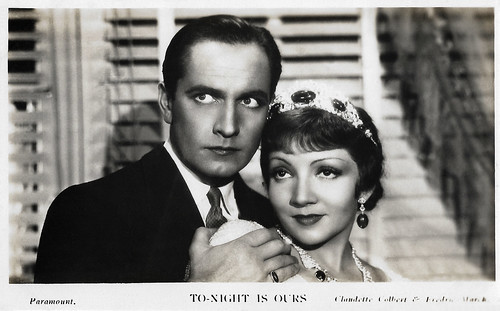
British postcard in the Filmshots series by Film Weekly. Photo: Paramount. Fredric March and Claudette Colbert in Tonight is Ours (Stuart Walker, 1933).
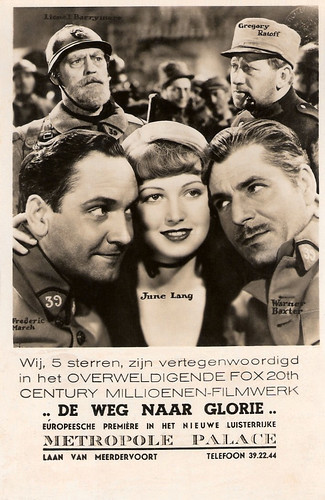
Dutch postcard for Metropole Palace, Den Haag (The Hague). Photos: 20th Century Fox. Fredric March, June Lang, Warner Baxter, Lionel Barrymore, and Gregory Ratoff in The Road to Glory (Howard Hawks, 1936). Caption: We, 5 stars, are represented in the overwhelming Fox 20th Century millions-film work The Way to Glory. European premiere in the new glorious Metropole Palace, Laan van Meerdervoort, telephone 39.22.44.
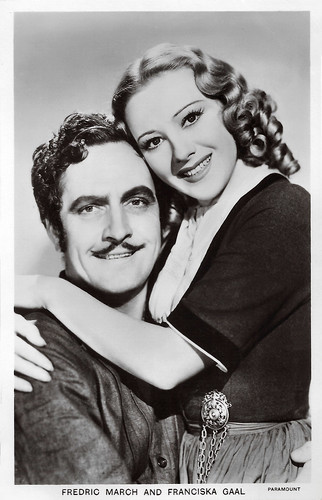
British postcard in the Film Partners Series, London, no. P 243. Photo: Paramount. Fredric March and Franciska Gaal in The Buccaneer (Cecil B. DeMille, 1938).
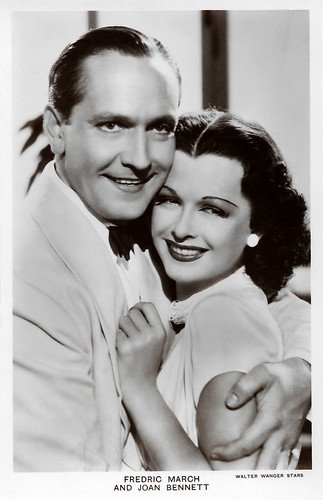
British postcard in the Film Partners Series, London, no. P 264. Photo: Walter Wanger. Fredric March and Joan Bennett in Trade Winds (Tay Garnett, 1938).
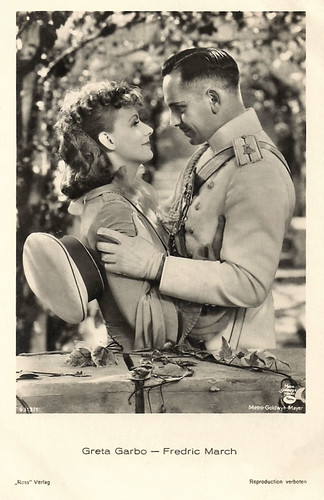
German postcard by Ross Verlag, no. 9313/1, 1935-1936. Photo: Metro-Goldwyn-Mayer. Greta Garbo and Fredric March in Anna Karenina (Clarence Brown 1935).
Men in anguish
In 1947, Fredric March won the highest awards for giving the best performances of the year in two distinct mediums: an Oscar for The Best Years of Our Lives (William Wyler, 1946) and a Tony for 'Years Ago'. Two years later, he was targeted for blacklisting by the House Un-American Activities Committee because of his supposed "leftist" politics.
March continued to play varying roles from heavy drama to light comedy and often portrayed men in anguish, such as Willy Loman in Death of a Salesman (Laslo Benedek, 1951). As his career advanced he progressed from leading man to character actor.
After 1958, he worked mostly on stage. On stage, he won two Tony Awards as Best Actor (Dramatic), the first in 1947 for his performance in Ruth Gordon's 'Years Ago', an award shared with José Ferrer for 'Cyrano de Bergerac', and the second, ten years later, in 1957, for his landmark performance in Eugene O'Neill's 'Long Day's Journey Into Night'. He was also nominated in the same category in 1962 for Paddy Chayefsky's 'Gideon'.
On-screen, March co-starred with Spencer Tracy in the film Inherit the Wind (Stanley Kramer, 1960), in which he played a dramatised version of famous orator and political figure William Jennings Bryan. In the 1960s, March played President Jordan Lyman in the political thriller Seven Days in May (John Frankenheimer, 1964), in which he co-starred with Burt Lancaster , Kirk Douglas , and Edmond O'Brien. The part earned March a Golden Globe nomination as Best Actor.
For a while after undergoing major surgery for prostate cancer in 1970, it seemed March's acting career was finished. However, he was able to give one final great performance in The Iceman Cometh (John Frankenheimer, 1973) with Lee Marvin and Robert Ryan.
In 1975, Fredric March died of prostate cancer in Los Angeles. He was married twice. From 1925 till 1927, he was married to Ellis Baker. In 1927 he married actress Florence Eldridge with whom he adopted two children, Penelope ("Penny", 1932) and Anthony (1934). The couple remained together till his death.
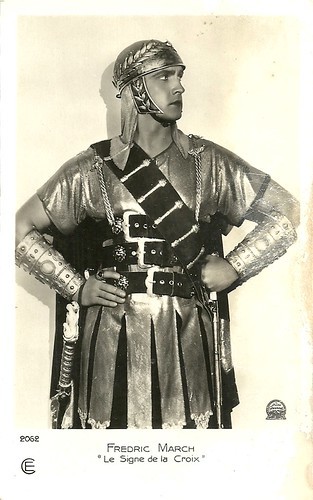
French postcard by Editions Cinémagazine, no. 2062. Photo: Paramount. Fredric March in the American epic film The Sign of the Cross (Cecil B. DeMille, 1932).
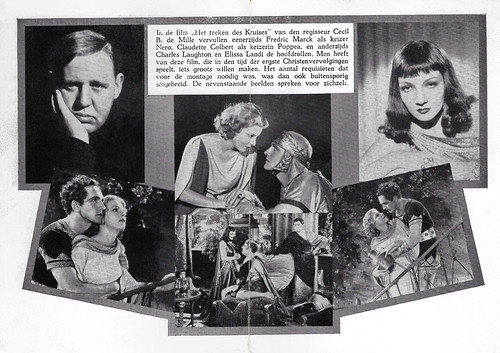
Dutch flyer, part 2. Charles Laughton , Fredric March, Elissa Landi, and Claudette Colbert in The Sign of the Cross (Cecil B. DeMille, 1932).
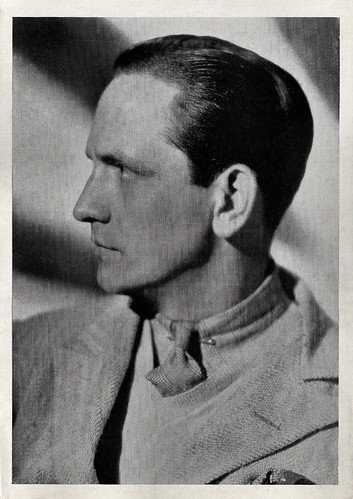
Dutch flyer, part 3. Fredric March in The Sign of the Cross (Cecil B. DeMille, 1932).
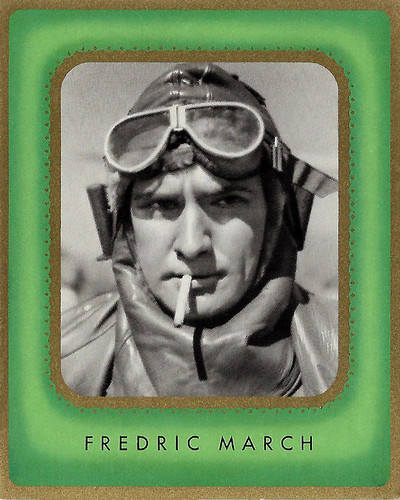
German collectors card by Ross Verlag in the Bunte Filmbilder series, Bild no. 212, for Lloyd Zigaretten. Photo: Paramount. Fredric March in The Eagle and the Hawk (Stuart Walker, 1933).
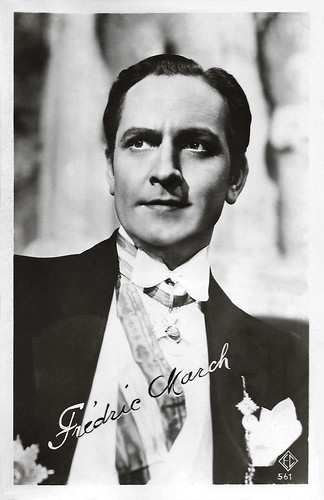
French postcard by EC, no. 561. Photo: Paramount Pictures. Fredric March in Death Takes a Holiday (Mitchell Leisen, 1934).
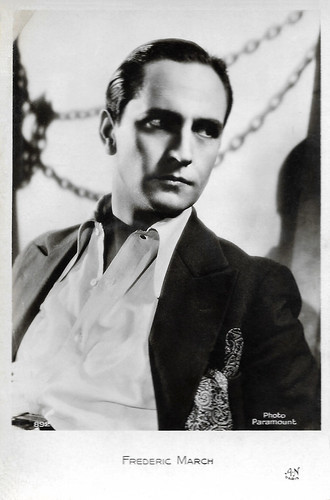
French postcard by A.N., Paris, no. 892. Photo: Paramount.
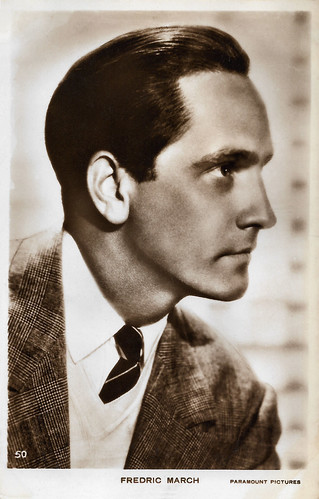
British Real Photograph postcard, no. 50. Photo: Paramount Pictures.
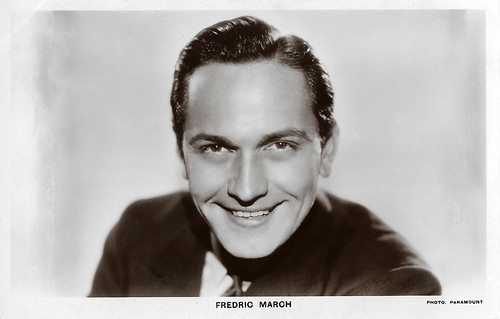
British postcard in the Picturegoer Series, London, no. 488b. Photo: Paramount.
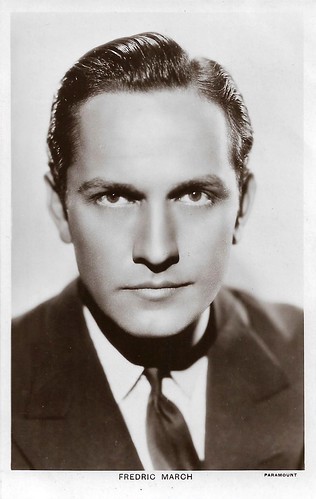
British postcard in the Picturegoer Series, London, no. 488c. Photo: Paramount.
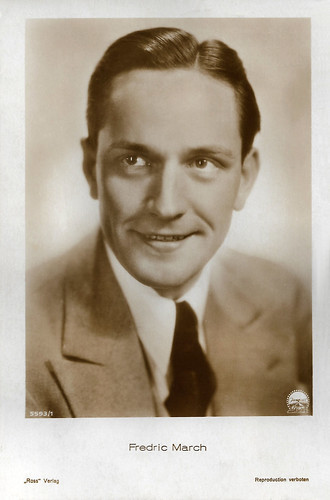
German postcard by Ross Verlag, no. 5593/1, 1930-1931. Photo: Paramount.
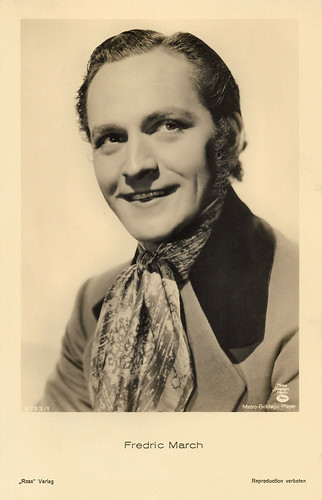
German postcard by Ross Verlag, no. 8793/1, 1933-1934. Photo: Metro-Goldwyn-Mayer. Fredric March in The Barretts of Wimpole Street (Sidney Franklin, 1934).
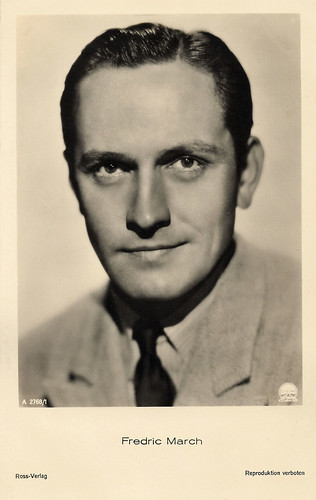
German postcard by Ross Verlag, no. A 2768/1, 1939-1940. Photo: Paramount.
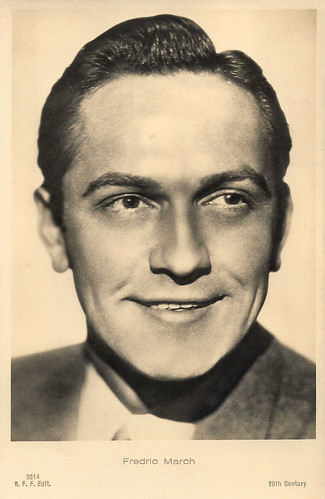
Italian postcard by B.F.F. Edit., no. 3514. Photo: 20th Century.
Sources: (IMDb), Wikipedia, and .

French postcard by Erpé, no. 611. Photo: Vitagraph. Fredric March in Anthony Adverse (Mervyn LeRoy, Michael Curtiz, 1936).

American film still by Paramount, no. 1394-120. Fredric March and Elissa Landi in The Sign of the Cross (Cecil B. DeMille, 1932).

British postcard by Abdulla Cigarettes, no. 27. Photo: M.G.M. Fredric March and Norma Shearer in The Barretts of Wimpole Street (Sidney Franklin, 1934).

British postcard by De Reszke Cigarettes, no. 17.

British postcard in the Colourgraph Series, no. C175. Photo: Paramount.

British postcard in the Real Photogravure Portrait series. Photo: Fredric March in Anthony Adverse (Mervyn LeRoy, 1936).
A rare protean quality to his acting
Fredric March was born Ernest Frederick McIntyre Bickel in 1897 in Racine, Wisconsin, USA. He was the son of Cora Brown Marcher, a schoolteacher from England, and John F. Bickel, a devout Presbyterian Church elder who worked in the wholesale hardware business. March attended the Winslow Elementary School, Racine High School, and the University of Wisconsin–Madison.
He served in the United States Army during World War I as an artillery lieutenant. After the war, he began a career in banking but in 1920 found himself cast as an extra in films being produced in New York. In 1924, he shortened Frederick to Fredric, shortened his mother's maiden name from Marcher to March, and his stage name was born.
Fredric March starred on the Broadway stage first in 1926 and would return there between screen appearances later on. He won plaudits and an Academy Award nomination for his send-up of John Barrymore in The Royal Family of Broadway (George Cukor, Cyril Gardner, 1930) opposite Ina Claire.
March would win the Oscar for Best Actor for Dr. Jekyll and Mr. Hyde (Rouben Mamoulian, 1931) and three more Academy Award nominations would come his way. Wikipedia : "Like Laurence Olivier , March had a rare protean quality to his acting that allowed him to assume almost any persona convincingly, from Robert Browning to William Jennings Bryan to Dr. Jekyll - or Mr. Hyde."
He starred in a series of classic films based on stage hits and classic novels like Design for Living (Ernst Lubitsch, 1933) with Gary Cooper and Miriam Hopkins , Death Takes a Holiday (Mitchell Leisen, 1934), Les Misérables (Richard Boleslawski, 1935) with Charles Laughton , and Anna Karenina (Clarence Brown, 1935) with Greta Garbo .
He also played the title figure in Anthony Adverse (Mervyn LeRoy, 1936) with Olivia de Havilland , and was the original Norman Maine in A Star is Born (William A. Wellman, 1937) with Janet Gaynor , for which he received his third Academy Award nomination.
In 1936, March co-founded the Hollywood Anti-Nazi League (HANL), along with writers Dorothy Parker and Donald Ogden Stewart, director Fritz Lang , and composer Oscar Hammerstein. In 1938, March was one of many Hollywood personalities investigated by the House of Committee on Un-American Activities (HUAC) and the hunt for Communists in the film community. In July 1940, he was again questioned by a HUAC subcommittee led by Representative Martin Dies.

French postcard by Editions Cinémagazine, no. 2063. Photo: Paramount. Fredric March and Elissa Landi in the American epic film The Sign of the Cross (Cecil B. DeMille, 1932).

British postcard in the Filmshots series by Film Weekly. Photo: Paramount. Fredric March and Claudette Colbert in Tonight is Ours (Stuart Walker, 1933).

Dutch postcard for Metropole Palace, Den Haag (The Hague). Photos: 20th Century Fox. Fredric March, June Lang, Warner Baxter, Lionel Barrymore, and Gregory Ratoff in The Road to Glory (Howard Hawks, 1936). Caption: We, 5 stars, are represented in the overwhelming Fox 20th Century millions-film work The Way to Glory. European premiere in the new glorious Metropole Palace, Laan van Meerdervoort, telephone 39.22.44.

British postcard in the Film Partners Series, London, no. P 243. Photo: Paramount. Fredric March and Franciska Gaal in The Buccaneer (Cecil B. DeMille, 1938).

British postcard in the Film Partners Series, London, no. P 264. Photo: Walter Wanger. Fredric March and Joan Bennett in Trade Winds (Tay Garnett, 1938).

German postcard by Ross Verlag, no. 9313/1, 1935-1936. Photo: Metro-Goldwyn-Mayer. Greta Garbo and Fredric March in Anna Karenina (Clarence Brown 1935).
Men in anguish
In 1947, Fredric March won the highest awards for giving the best performances of the year in two distinct mediums: an Oscar for The Best Years of Our Lives (William Wyler, 1946) and a Tony for 'Years Ago'. Two years later, he was targeted for blacklisting by the House Un-American Activities Committee because of his supposed "leftist" politics.
March continued to play varying roles from heavy drama to light comedy and often portrayed men in anguish, such as Willy Loman in Death of a Salesman (Laslo Benedek, 1951). As his career advanced he progressed from leading man to character actor.
After 1958, he worked mostly on stage. On stage, he won two Tony Awards as Best Actor (Dramatic), the first in 1947 for his performance in Ruth Gordon's 'Years Ago', an award shared with José Ferrer for 'Cyrano de Bergerac', and the second, ten years later, in 1957, for his landmark performance in Eugene O'Neill's 'Long Day's Journey Into Night'. He was also nominated in the same category in 1962 for Paddy Chayefsky's 'Gideon'.
On-screen, March co-starred with Spencer Tracy in the film Inherit the Wind (Stanley Kramer, 1960), in which he played a dramatised version of famous orator and political figure William Jennings Bryan. In the 1960s, March played President Jordan Lyman in the political thriller Seven Days in May (John Frankenheimer, 1964), in which he co-starred with Burt Lancaster , Kirk Douglas , and Edmond O'Brien. The part earned March a Golden Globe nomination as Best Actor.
For a while after undergoing major surgery for prostate cancer in 1970, it seemed March's acting career was finished. However, he was able to give one final great performance in The Iceman Cometh (John Frankenheimer, 1973) with Lee Marvin and Robert Ryan.
In 1975, Fredric March died of prostate cancer in Los Angeles. He was married twice. From 1925 till 1927, he was married to Ellis Baker. In 1927 he married actress Florence Eldridge with whom he adopted two children, Penelope ("Penny", 1932) and Anthony (1934). The couple remained together till his death.

French postcard by Editions Cinémagazine, no. 2062. Photo: Paramount. Fredric March in the American epic film The Sign of the Cross (Cecil B. DeMille, 1932).

Dutch flyer, part 2. Charles Laughton , Fredric March, Elissa Landi, and Claudette Colbert in The Sign of the Cross (Cecil B. DeMille, 1932).

Dutch flyer, part 3. Fredric March in The Sign of the Cross (Cecil B. DeMille, 1932).

German collectors card by Ross Verlag in the Bunte Filmbilder series, Bild no. 212, for Lloyd Zigaretten. Photo: Paramount. Fredric March in The Eagle and the Hawk (Stuart Walker, 1933).

French postcard by EC, no. 561. Photo: Paramount Pictures. Fredric March in Death Takes a Holiday (Mitchell Leisen, 1934).

French postcard by A.N., Paris, no. 892. Photo: Paramount.

British Real Photograph postcard, no. 50. Photo: Paramount Pictures.

British postcard in the Picturegoer Series, London, no. 488b. Photo: Paramount.

British postcard in the Picturegoer Series, London, no. 488c. Photo: Paramount.

German postcard by Ross Verlag, no. 5593/1, 1930-1931. Photo: Paramount.

German postcard by Ross Verlag, no. 8793/1, 1933-1934. Photo: Metro-Goldwyn-Mayer. Fredric March in The Barretts of Wimpole Street (Sidney Franklin, 1934).

German postcard by Ross Verlag, no. A 2768/1, 1939-1940. Photo: Paramount.

Italian postcard by B.F.F. Edit., no. 3514. Photo: 20th Century.
Sources: (IMDb), Wikipedia, and .
Published on May 25, 2021 22:00
May 24, 2021
Carlos und Elisabeth (1924)
The story of the German silent historical drama Carlos und Elisabeth/Carlos and Elisabeth (Richard Oswald, 1924) is based on 'Don Carlos', the play by Friedrich Schiller and the opera by Giuseppe Verdi. Director Richard Oswald modelled the film's visuals on a staging of the play by Max Reinhardt at the Deutsches Theater. The film is abundantly operatic, with romantic passion and politics intertwining. The main character is King Philip of Spain (Eugen Klöpfer), who married Mary Tudor Queen of England, and wanted to marry her sister, Elizabeth I. His second wife was a French princess, Elisabeth de Valois (Dagny Servaes), who thought she was intended for his son Carlos (Conrad Veidt), the crown prince of Spain. Don Carlos is a poetic and liberal young man who is the hope of those who would like to see freedom of religion, while his father is a promoter of the Inquisition and oppression both in Spain and in Flanders. Carlos remains in love with Elisabeth.

German postcard by Ross Verlag, Berlin, no. 674/1. Photo: Krabbe / ROFilm. Dagny Servaes as Elisabeth of Valois, wife of Philip II and Queen of Spain in Carlos und Elisabeth/Carlos and Elisabeth (Richard Oswald, 1924).
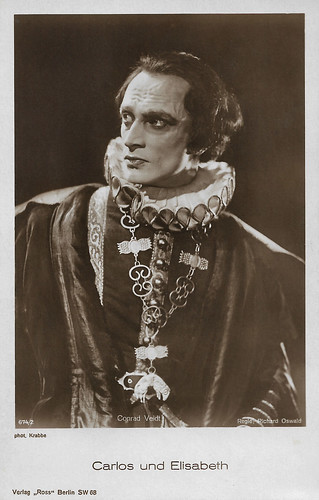
German postcard by Ross Verlag, Berlin, no. 674/2. Photo: Krabbe / RO-Film. Conrad Veidt as Don Carlos in Carlos und Elisabeth/Carlos and Elisabeth (Richard Oswald, 1924).
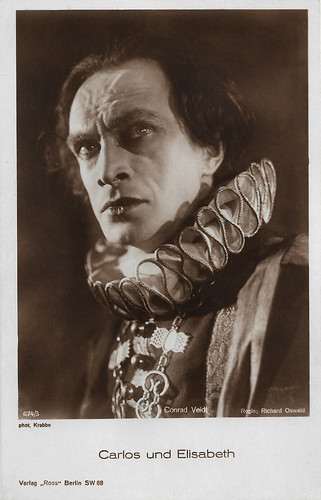
German postcard by Ross Verlag, Berlin, no. 674/3. Photo: Krabbe / RO-Film. Conrad Veidt as Don Carlos in Carlos und Elisabeth/Carlos and Elisabeth (Richard Oswald, 1924).
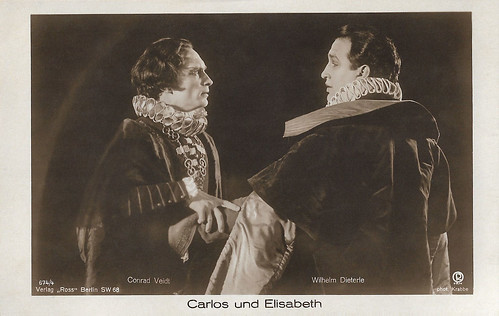
German postcard by Ross Verlag, Berlin, no. 674/4. Photo: Krabbe / RO-Film. Conrad Veidt as Don Carlos and Wilhelm Dieterle as Marquis Posa in Carlos und Elisabeth/Carlos and Elisabeth (Richard Oswald, 1924).
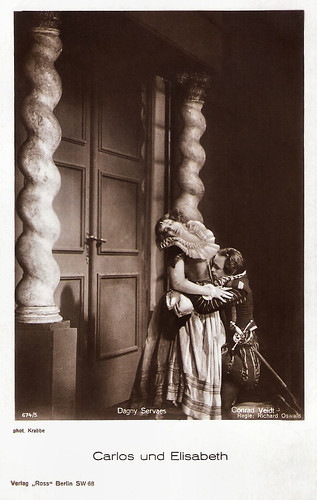
German postcard by Ross Verlag, Berlin, no. 674/5. Photo: Krabbe / ROFilm. Dagny Servaes and Conrad Veidt in Carlos und Elisabeth/Carlos and Elisabeth (Richard Oswald, 1924).
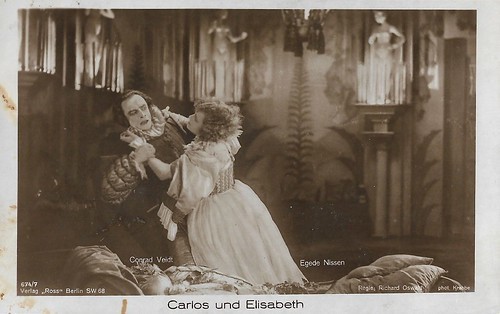
German postcard by Ross Verlag, Berlin, no. 674/7. Photo: Krabbe / ROFilm. Conrad Veidt as Don Carlos and Aud Egede Nissen as the Princess of Eboli in Carlos und Elisabeth/Carlos and Elisabeth (Richard Oswald, 1924).
Sources: Wikipedia and IMDb.

German postcard by Ross Verlag, Berlin, no. 674/1. Photo: Krabbe / ROFilm. Dagny Servaes as Elisabeth of Valois, wife of Philip II and Queen of Spain in Carlos und Elisabeth/Carlos and Elisabeth (Richard Oswald, 1924).

German postcard by Ross Verlag, Berlin, no. 674/2. Photo: Krabbe / RO-Film. Conrad Veidt as Don Carlos in Carlos und Elisabeth/Carlos and Elisabeth (Richard Oswald, 1924).

German postcard by Ross Verlag, Berlin, no. 674/3. Photo: Krabbe / RO-Film. Conrad Veidt as Don Carlos in Carlos und Elisabeth/Carlos and Elisabeth (Richard Oswald, 1924).

German postcard by Ross Verlag, Berlin, no. 674/4. Photo: Krabbe / RO-Film. Conrad Veidt as Don Carlos and Wilhelm Dieterle as Marquis Posa in Carlos und Elisabeth/Carlos and Elisabeth (Richard Oswald, 1924).

German postcard by Ross Verlag, Berlin, no. 674/5. Photo: Krabbe / ROFilm. Dagny Servaes and Conrad Veidt in Carlos und Elisabeth/Carlos and Elisabeth (Richard Oswald, 1924).

German postcard by Ross Verlag, Berlin, no. 674/7. Photo: Krabbe / ROFilm. Conrad Veidt as Don Carlos and Aud Egede Nissen as the Princess of Eboli in Carlos und Elisabeth/Carlos and Elisabeth (Richard Oswald, 1924).
Sources: Wikipedia and IMDb.
Published on May 24, 2021 22:00
May 23, 2021
Ben Lyon
Ben Lyon (1901-1979) was an American stage, film, radio, and TV performer, as well as a studio manager. During the late 1920s and early 1930s, Lyon was an average boyish, easy-going, highly appealing film personality. He is best remembered for his part of the courageous aviator in Howard Hughes' World War I epic Hell's Angels (1930). Later, he and his wife Bebe Daniels became very popular in England.

German postcard by Ross Verlag Foreign, no. 3477/1. Photo: Defina / First National.

German postcard by Ross Verlag, no. 3477/2, 1928-1929. Photo: Defina / First National.
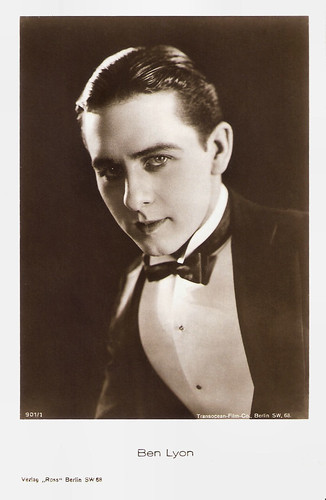
German postcard by Ross Verlag, Berlin, no. 901/1, 1925-1926. Photo: Transocean-Film-Co., Berlin.
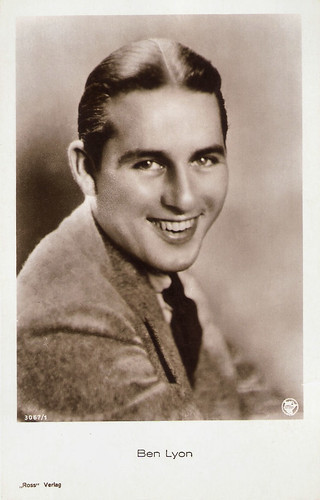
German postcard by Ross Verlag, Berlin, no. 3067/1, 1928-1929. Photo: First National.
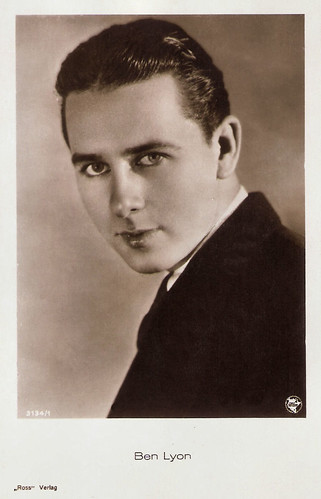
German postcard by Ross Verlag, Berlin, no. 3134/1, 1928-1929. Photo: First National.
A legendary aviation film
Ben Lyon was born in 1901 in Atlanta, Georgia, into a Jewish family. Lyon went to school at Baltimore City College.
He began his theatre career as a 17-year-old alongside Jeanne Eagels. His early plays, in which he appeared in New York City (also on Broadway), include 'Mary the Third' and 'Wonderful Thing'.
Also at 17, he first appeared in front of the movie camera, and from the early 1920s, Ben Lyon appeared regularly in films. He attracted attention in the highly successful film Flaming Youth (John Francis Dillon, 1923) and became a leading man opposite such female stars as Pola Negri , Gloria Swanson , Colleen Moore , Barbara Lamarr, Viola Dana , Blanche Sweet, etc.
Many of his silent films in that decade also enjoyed some popularity in Germany and Austria, so Friedrich Zelnik offered him to play the male lead alongside Zelnik's wife Lya Mara in his screen romance Das tanzende Wien/Dancing Vienna (Friedrich Zelnik, 1927). Filming took place in August and September 1927 in both Vienna (exterior shots) and Berlin-Staaken (studio shots).
It was not until the dawn of the sound film era that the actor with the distinctive center parting made his breakthrough in his homeland: he became instantly famous with the role of Monte Rutledge in Howard Hughes' legendary aviation film Hell's Angels (1930), in which Lyon, also an avid aviator in his private life, portrayed a war-volunteer pilot at the time of the First World War.
Despite numerous follow-up roles - Ben Lyon appeared in around two and a half dozen, consistently minor films over the next five years - and great popularity with the ladies, Lyon's career stagnated.
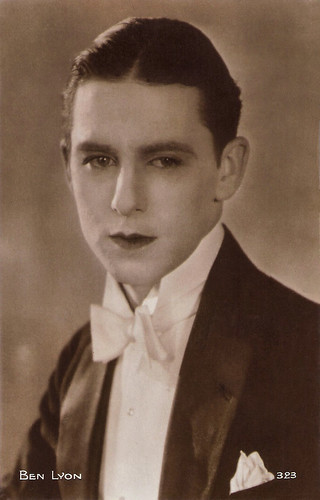
French postcard by Editions Cinémagazine, no. 323.

French postcard by J.R.P.R., no. 213. Photo: Metro-Goldwyn (sic: The film was a First National production, and was not produced by MGM). Ben Lyon and Billie Dove in The Tender Hour (George Fitzmaurice, 1927).
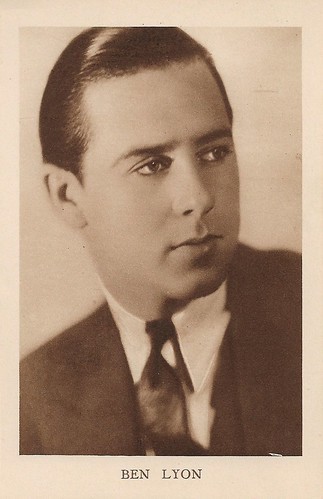
Belgian postcard by Weekblad "Cinema", Antwerp.
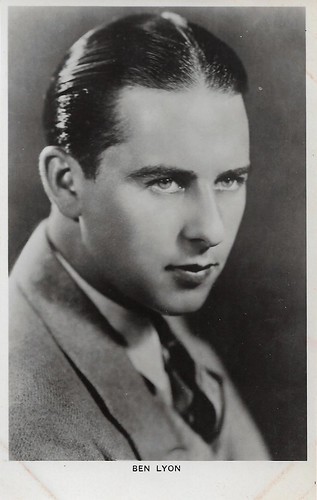
British postcard in the Picturegoer Series, London, no. 213a.
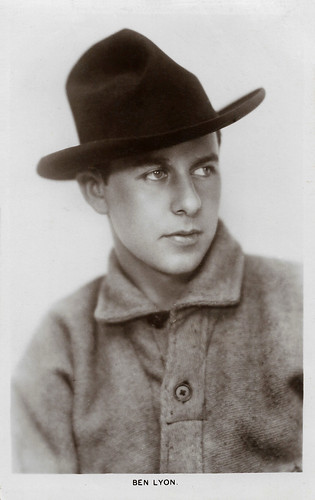
British postcard in the Picturegoer Series, London, no. 213b.
The Man who gave Marilyn her first studio contract
Ben Lyon and his wife (since 1930), film star Bebe Daniels , decided to move to England in 1936. In London, he continued to work as a film actor but made a name for himself mainly as an entertainer on the radio and in music halls. His partner in song and dance was regularly his wife Bebe.
During the Second World War, Ben Lyon temporarily reached the height of his popularity when, unlike many other US citizens, he did not travel home to the United States in the face of the German threat but stayed. In addition, he showed solidarity with the British through his work for the BBC and volunteered as a bomber pilot in the Royal Air Force.
In 1942, Ben Lyon was drafted into the American 8th Army Air Force with the rank of Lieutenant-Colonel. Between 1940 (shortly after the war started) and 1949 Lyon ran the BBC radio show 'Hi Gang!', a domestic sitcom featuring Lyon, Daniels, and Vic Oliver . From 1950 to 1961 Lyon also run its sequel, 'Life with the Lyons', starring Lyon, Daniels, and their children. Between 1955 and 1960 Life with the Lyons was also broadcast on TV, while in 1954-1955 also two feature films were made.
At the end of the war in 1945, Lyon returned to civilian life and was appointed Executive Talent Director at the London branch of 20th Century Fox. From 1946 to 1948, Lyon was assigned to the same position in Hollywood. It was then that he gave Marilyn Monroe , whom he considered the next Jean Harlow , the leading actress of Hell's Angels, her first studio contract.
Subsequently, until 1951, he was assigned as assistant to the head of production in London. Lyon was the subject of This Is Your Life in March 1963, when he was surprised by Eamonn Andrews at the BBC Television Theatre.
After Bebe Daniels 's death in 1971, Ben Lyon married actress Marian Nixon (1904-1983) in 1974. He died of a heart attack in 1979 at the age of 78 while on a cruise across the Pacific on Queen Elizabeth 2. He was interred at the Hollywood Forever Cemetery, next to his first wife Bebe Daniels . In 1975 Jill Allgood, a good friend of Lyon and Daniels and collaborator on Life with the Lyons, published the biography 'Bebe and Ben'.
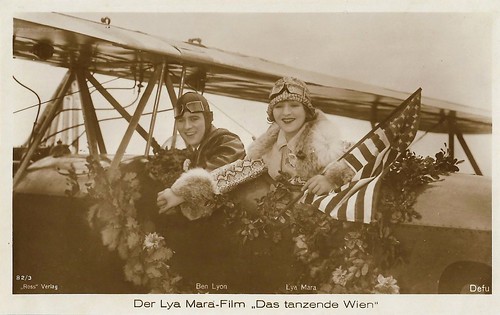
German postcard by Ross Verlag, no. 82/3. Photo: Defu. Lya Mara and Ben Lyon in Das tanzende Wien/Dancing Vienna (Friedrich Zelnik, 1927).
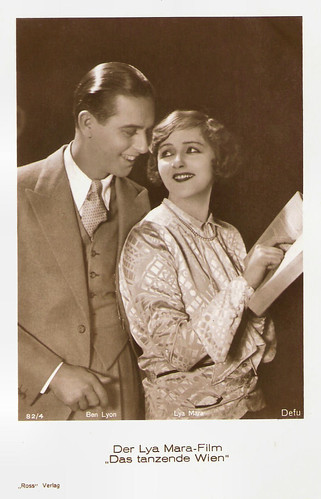
German postcard by Ross Verlag, no. 82/4. Photo: Defu. Lya Mara and Ben Lyon in Das tanzende Wien/Dancing Vienna (Friedrich Zelnik, 1927).
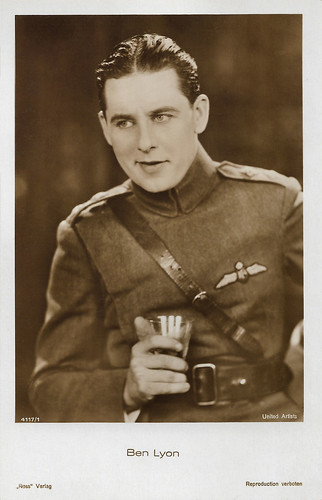
German postcard by Ross Verlag, Berlin, no. 4117/1, 1929-1930. Photo: United Artists. Ben Lyon in Hell's Angels (Howard Hughes, 1930).
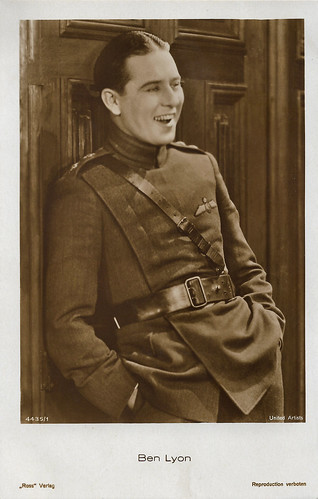
German postcard by Ross Verlag, Berlin, no. 4435/1, 1929-1930. Photo: United Artists. Ben Lyon in Hell's Angels (Howard Hughes, 1930).
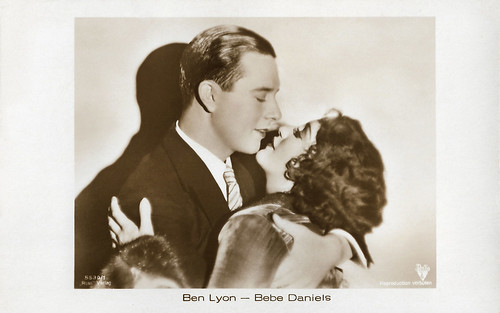
German postcard by Ross Verlag, no. 5539/1, 1930-1931. Photo: Radio Pictures. Ben Lyon and Bebe Daniels in Alias French Gertie (George Archainbaud, 1930).
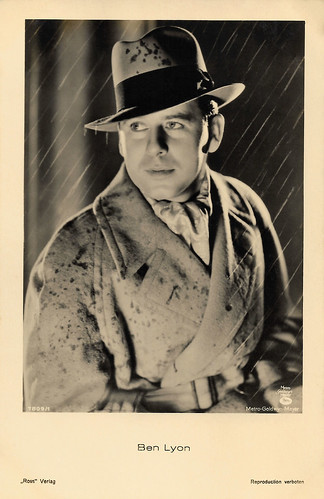
German postcard by Ross Verlag, no. 8909/1, 1932-1933. Photo: Metro-Goldwyn-Mayer.

British postcard in the Filmshots Series by Film Weekly. Photo: United Artists. Claudette Colbert and Ben Lyon in the pre-Code film I Cover the Waterfront (James Cruze, 1933).
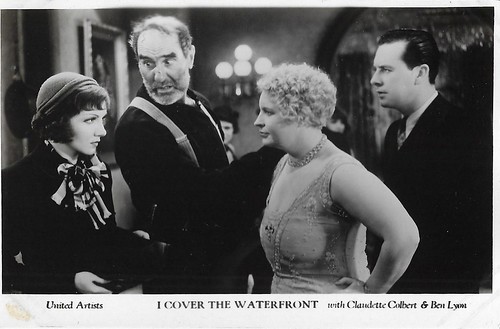
British postcard in the Filmshots Series by Film Weekly. Photo: United Artists. Claudette Colbert , Ernest Torrence , and Ben Lyon in the pre-Code film I Cover the Waterfront (James Cruze, 1933). The other woman could be Claudia Coleman.
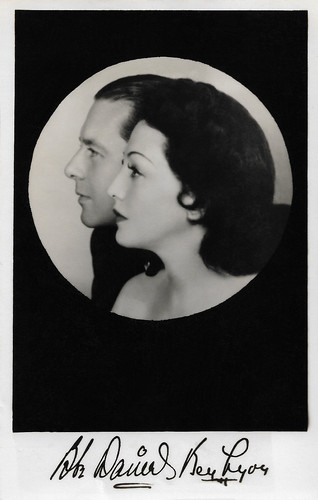
British autograph card. Bebe Daniels and Ben Lyon.

British postcard in the Picturegoer Series, London, no. D 502. Photo: Exclusive. Bebe Daniels-Lyon , Ben Lyon, Richard Lyon, and Barbara Lyon in Life with the Lyons (Val Guest, 1954).
Sources: Wikipedia (German and English) and .

German postcard by Ross Verlag Foreign, no. 3477/1. Photo: Defina / First National.

German postcard by Ross Verlag, no. 3477/2, 1928-1929. Photo: Defina / First National.

German postcard by Ross Verlag, Berlin, no. 901/1, 1925-1926. Photo: Transocean-Film-Co., Berlin.

German postcard by Ross Verlag, Berlin, no. 3067/1, 1928-1929. Photo: First National.

German postcard by Ross Verlag, Berlin, no. 3134/1, 1928-1929. Photo: First National.
A legendary aviation film
Ben Lyon was born in 1901 in Atlanta, Georgia, into a Jewish family. Lyon went to school at Baltimore City College.
He began his theatre career as a 17-year-old alongside Jeanne Eagels. His early plays, in which he appeared in New York City (also on Broadway), include 'Mary the Third' and 'Wonderful Thing'.
Also at 17, he first appeared in front of the movie camera, and from the early 1920s, Ben Lyon appeared regularly in films. He attracted attention in the highly successful film Flaming Youth (John Francis Dillon, 1923) and became a leading man opposite such female stars as Pola Negri , Gloria Swanson , Colleen Moore , Barbara Lamarr, Viola Dana , Blanche Sweet, etc.
Many of his silent films in that decade also enjoyed some popularity in Germany and Austria, so Friedrich Zelnik offered him to play the male lead alongside Zelnik's wife Lya Mara in his screen romance Das tanzende Wien/Dancing Vienna (Friedrich Zelnik, 1927). Filming took place in August and September 1927 in both Vienna (exterior shots) and Berlin-Staaken (studio shots).
It was not until the dawn of the sound film era that the actor with the distinctive center parting made his breakthrough in his homeland: he became instantly famous with the role of Monte Rutledge in Howard Hughes' legendary aviation film Hell's Angels (1930), in which Lyon, also an avid aviator in his private life, portrayed a war-volunteer pilot at the time of the First World War.
Despite numerous follow-up roles - Ben Lyon appeared in around two and a half dozen, consistently minor films over the next five years - and great popularity with the ladies, Lyon's career stagnated.

French postcard by Editions Cinémagazine, no. 323.

French postcard by J.R.P.R., no. 213. Photo: Metro-Goldwyn (sic: The film was a First National production, and was not produced by MGM). Ben Lyon and Billie Dove in The Tender Hour (George Fitzmaurice, 1927).

Belgian postcard by Weekblad "Cinema", Antwerp.

British postcard in the Picturegoer Series, London, no. 213a.

British postcard in the Picturegoer Series, London, no. 213b.
The Man who gave Marilyn her first studio contract
Ben Lyon and his wife (since 1930), film star Bebe Daniels , decided to move to England in 1936. In London, he continued to work as a film actor but made a name for himself mainly as an entertainer on the radio and in music halls. His partner in song and dance was regularly his wife Bebe.
During the Second World War, Ben Lyon temporarily reached the height of his popularity when, unlike many other US citizens, he did not travel home to the United States in the face of the German threat but stayed. In addition, he showed solidarity with the British through his work for the BBC and volunteered as a bomber pilot in the Royal Air Force.
In 1942, Ben Lyon was drafted into the American 8th Army Air Force with the rank of Lieutenant-Colonel. Between 1940 (shortly after the war started) and 1949 Lyon ran the BBC radio show 'Hi Gang!', a domestic sitcom featuring Lyon, Daniels, and Vic Oliver . From 1950 to 1961 Lyon also run its sequel, 'Life with the Lyons', starring Lyon, Daniels, and their children. Between 1955 and 1960 Life with the Lyons was also broadcast on TV, while in 1954-1955 also two feature films were made.
At the end of the war in 1945, Lyon returned to civilian life and was appointed Executive Talent Director at the London branch of 20th Century Fox. From 1946 to 1948, Lyon was assigned to the same position in Hollywood. It was then that he gave Marilyn Monroe , whom he considered the next Jean Harlow , the leading actress of Hell's Angels, her first studio contract.
Subsequently, until 1951, he was assigned as assistant to the head of production in London. Lyon was the subject of This Is Your Life in March 1963, when he was surprised by Eamonn Andrews at the BBC Television Theatre.
After Bebe Daniels 's death in 1971, Ben Lyon married actress Marian Nixon (1904-1983) in 1974. He died of a heart attack in 1979 at the age of 78 while on a cruise across the Pacific on Queen Elizabeth 2. He was interred at the Hollywood Forever Cemetery, next to his first wife Bebe Daniels . In 1975 Jill Allgood, a good friend of Lyon and Daniels and collaborator on Life with the Lyons, published the biography 'Bebe and Ben'.

German postcard by Ross Verlag, no. 82/3. Photo: Defu. Lya Mara and Ben Lyon in Das tanzende Wien/Dancing Vienna (Friedrich Zelnik, 1927).

German postcard by Ross Verlag, no. 82/4. Photo: Defu. Lya Mara and Ben Lyon in Das tanzende Wien/Dancing Vienna (Friedrich Zelnik, 1927).

German postcard by Ross Verlag, Berlin, no. 4117/1, 1929-1930. Photo: United Artists. Ben Lyon in Hell's Angels (Howard Hughes, 1930).

German postcard by Ross Verlag, Berlin, no. 4435/1, 1929-1930. Photo: United Artists. Ben Lyon in Hell's Angels (Howard Hughes, 1930).

German postcard by Ross Verlag, no. 5539/1, 1930-1931. Photo: Radio Pictures. Ben Lyon and Bebe Daniels in Alias French Gertie (George Archainbaud, 1930).

German postcard by Ross Verlag, no. 8909/1, 1932-1933. Photo: Metro-Goldwyn-Mayer.

British postcard in the Filmshots Series by Film Weekly. Photo: United Artists. Claudette Colbert and Ben Lyon in the pre-Code film I Cover the Waterfront (James Cruze, 1933).

British postcard in the Filmshots Series by Film Weekly. Photo: United Artists. Claudette Colbert , Ernest Torrence , and Ben Lyon in the pre-Code film I Cover the Waterfront (James Cruze, 1933). The other woman could be Claudia Coleman.

British autograph card. Bebe Daniels and Ben Lyon.

British postcard in the Picturegoer Series, London, no. D 502. Photo: Exclusive. Bebe Daniels-Lyon , Ben Lyon, Richard Lyon, and Barbara Lyon in Life with the Lyons (Val Guest, 1954).
Sources: Wikipedia (German and English) and .
Published on May 23, 2021 22:00
May 22, 2021
The Hangover (2009)
The Hangover (2009) is an American comedy film directed by Todd Phillips, co-produced with Daniel Goldberg, and written by Jon Lucas and Scott Moore. It is the first installment in The Hangover trilogy. The film stars Bradley Cooper, Ed Helms, Zach Galifianakis, Heather Graham, Justin Bartha, Ken Jeong, and Jeffrey Tambor.
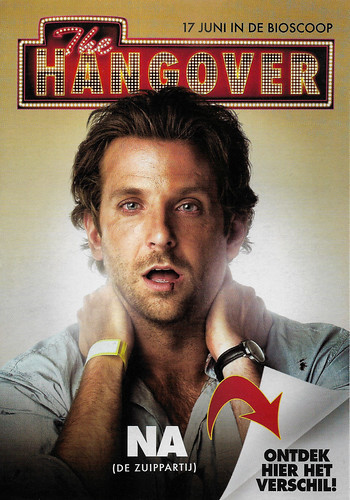
Belgian postcard by Boomerang (Front). Photo: Legendary / Warner Bros. Bradley Cooper in The Hangover (Todd Phillips, 2009).

Belgian postcard by Boomerang (Flipside). Photo: Legendary / Warner Bros. Bradley Cooper in The Hangover (Todd Phillips, 2009).

Belgian postcard by Boomerang. Photo: Legendary / Warner Bros. Publicity still for The Hangover (Todd Phillips, 2009).
Remember last night?
Jon Lucas and Scott Moore wrote the script of The Hangover after executive producer Chris Bender's friend disappeared and had a large bill after being sent to a strip club.
After Lucas and Moore sold it to the studio for $2 million, director Todd Phillips and Jeremy Garelick rewrote the script to include a tiger as well as a subplot involving a baby and a police cruiser, and also including - as himself - boxer Mike Tyson whose tiger the four friends appear to have stolen.
The Hangover tells the story of four friends, who travel to Las Vegas for a 24-hour stag party. Doug, the future husband (Justin Bartha), is joined by his two friends, the schoolteacher Phil (Bradley Cooper) and the dentist Stu (Ed Helms).
Joining them is the bride's brother Alan (Zach Galifianakis), an overweight slob with a Haystacks Calhoun beard, and an injunction against coming within 200 feet of a school building.
However, Phil, Stu, and Alan wake up with Doug missing and no memory of the previous night's events and must find the groom before the wedding can take place.

Belgian postcard by Boomerang (Front). Photo: Legendary / Warner Bros. Zach Galifianakis in The Hangover (Todd Phillips, 2009).
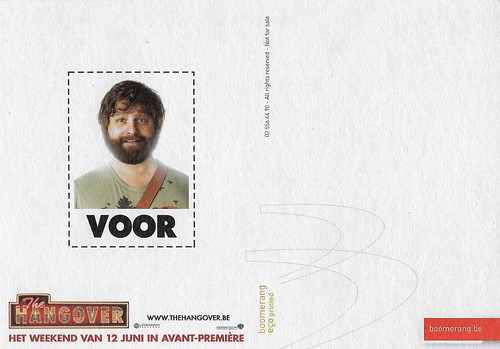
Belgian postcard by Boomerang (Flipside). Photo: Legendary / Warner Bros. Zach Galifianakis in The Hangover (Todd Phillips, 2009).
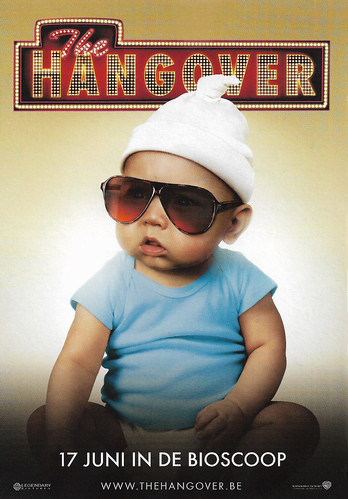
Belgian postcard by Boomerang. Photo: Legendary / Warner Bros. Publicity still for The Hangover (Todd Phillips, 2009).
A funny movie, flat out, all the way through
Filming of The Hangover took place in Nevada for 15 days, and during filming, the three main actors (Bradley Cooper, Ed Helms, and Zach Galifianakis) formed a real friendship.
The film was released in the USA on 5 June 2009 and two weeks later in Europe. It was a critical and commercial success.
Roger Ebert of the Chicago Sun-Times gave it three-and-a-half stars out of four: "The Hangover is a funny movie, flat out, all the way through. Its setup is funny. Every situation is funny. Most of the dialogue is funny almost line by line. At some point we actually find ourselves caring a little about what happened to the missing bridegroom -- and the fact that we almost care is funny, too."
The Hangover became the tenth-highest-grossing film of 2009, with a worldwide gross of over $467 million. The film won the Golden Globe Award for Best Motion Picture – Musical or Comedy and received multiple other accolades. It is the tenth-highest-grossing worldwide film of 2009, as well as the second-highest-grossing R-rated comedy ever in the United States, surpassing a record previously held by Beverly Hills Cop for almost 25 years.
A sequel, The Hangover Part II, was released in 2011, and a third and final installment, The Hangover Part III, was released in 2013. While both were also box-office hits, neither were well-received.
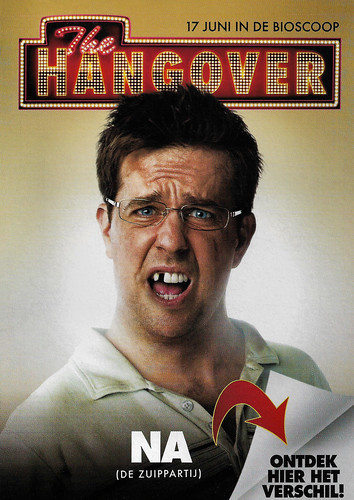
Belgian postcard by Boomerang (Front). Photo: Legendary / Warner Bros. Ed Helms in The Hangover (Todd Phillips, 2009).
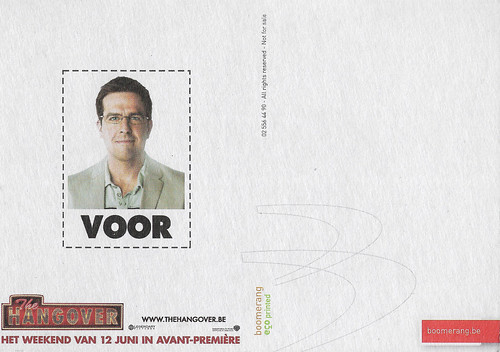
Belgian postcard by Boomerang (Flip side). Photo: Legendary / Warner Bros. Ed Helm in The Hangover (Todd Phillips, 2009).

Belgian postcard by Boomerang. Photo: Legendary / Warner Bros. Publicity still for The Hangover (Todd Phillips, 2009).
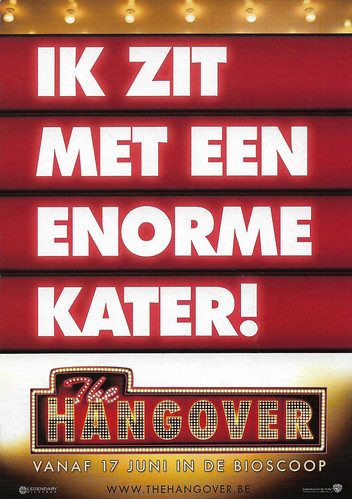
Belgian postcard by Boomerang. Photo: Legendary / Warner Bros. Publicity still for The Hangover (Todd Phillips, 2009). Caption: 'Ik zit met een enorme kater!', Dutch for both 'I have a huge hangover!' as well as 'I have a huge cat!'.

Belgian postcard by Boomerang (flipside). Photo: Legendary / Warner Bros. Publicity still for The Hangover (Todd Phillips, 2009). Caption: 'Niets is wat het lijkt als je dronken bent..', Dutch for both 'Nothing is what it seems when you're drunk..'.

Belgian postcard (door hanger) by Boomerang. Photo: Legendary / Warner Bros. Publicity still for The Hangover Part II (Todd Phillips, 2011). Caption: 'Kom binnen (het feest kan beginnen)', Dutch for 'Come in (let the party begin)'.
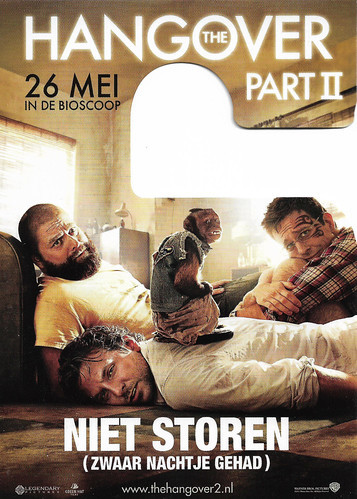
Belgian postcard (door hanger) by Boomerang. Photo: Legendary / Warner Bros. Publicity still for The Hangover Part II (Todd Phillips, 2011). Caption: 'Niet storen (zwaar nachtje gehad)', Dutch for 'Do not disturb (had a hard night)'.
Sources: Roger Ebert (RogerEbert.com), Wikipedia, and IMDb.

Belgian postcard by Boomerang (Front). Photo: Legendary / Warner Bros. Bradley Cooper in The Hangover (Todd Phillips, 2009).

Belgian postcard by Boomerang (Flipside). Photo: Legendary / Warner Bros. Bradley Cooper in The Hangover (Todd Phillips, 2009).

Belgian postcard by Boomerang. Photo: Legendary / Warner Bros. Publicity still for The Hangover (Todd Phillips, 2009).
Remember last night?
Jon Lucas and Scott Moore wrote the script of The Hangover after executive producer Chris Bender's friend disappeared and had a large bill after being sent to a strip club.
After Lucas and Moore sold it to the studio for $2 million, director Todd Phillips and Jeremy Garelick rewrote the script to include a tiger as well as a subplot involving a baby and a police cruiser, and also including - as himself - boxer Mike Tyson whose tiger the four friends appear to have stolen.
The Hangover tells the story of four friends, who travel to Las Vegas for a 24-hour stag party. Doug, the future husband (Justin Bartha), is joined by his two friends, the schoolteacher Phil (Bradley Cooper) and the dentist Stu (Ed Helms).
Joining them is the bride's brother Alan (Zach Galifianakis), an overweight slob with a Haystacks Calhoun beard, and an injunction against coming within 200 feet of a school building.
However, Phil, Stu, and Alan wake up with Doug missing and no memory of the previous night's events and must find the groom before the wedding can take place.

Belgian postcard by Boomerang (Front). Photo: Legendary / Warner Bros. Zach Galifianakis in The Hangover (Todd Phillips, 2009).

Belgian postcard by Boomerang (Flipside). Photo: Legendary / Warner Bros. Zach Galifianakis in The Hangover (Todd Phillips, 2009).

Belgian postcard by Boomerang. Photo: Legendary / Warner Bros. Publicity still for The Hangover (Todd Phillips, 2009).
A funny movie, flat out, all the way through
Filming of The Hangover took place in Nevada for 15 days, and during filming, the three main actors (Bradley Cooper, Ed Helms, and Zach Galifianakis) formed a real friendship.
The film was released in the USA on 5 June 2009 and two weeks later in Europe. It was a critical and commercial success.
Roger Ebert of the Chicago Sun-Times gave it three-and-a-half stars out of four: "The Hangover is a funny movie, flat out, all the way through. Its setup is funny. Every situation is funny. Most of the dialogue is funny almost line by line. At some point we actually find ourselves caring a little about what happened to the missing bridegroom -- and the fact that we almost care is funny, too."
The Hangover became the tenth-highest-grossing film of 2009, with a worldwide gross of over $467 million. The film won the Golden Globe Award for Best Motion Picture – Musical or Comedy and received multiple other accolades. It is the tenth-highest-grossing worldwide film of 2009, as well as the second-highest-grossing R-rated comedy ever in the United States, surpassing a record previously held by Beverly Hills Cop for almost 25 years.
A sequel, The Hangover Part II, was released in 2011, and a third and final installment, The Hangover Part III, was released in 2013. While both were also box-office hits, neither were well-received.

Belgian postcard by Boomerang (Front). Photo: Legendary / Warner Bros. Ed Helms in The Hangover (Todd Phillips, 2009).

Belgian postcard by Boomerang (Flip side). Photo: Legendary / Warner Bros. Ed Helm in The Hangover (Todd Phillips, 2009).

Belgian postcard by Boomerang. Photo: Legendary / Warner Bros. Publicity still for The Hangover (Todd Phillips, 2009).

Belgian postcard by Boomerang. Photo: Legendary / Warner Bros. Publicity still for The Hangover (Todd Phillips, 2009). Caption: 'Ik zit met een enorme kater!', Dutch for both 'I have a huge hangover!' as well as 'I have a huge cat!'.

Belgian postcard by Boomerang (flipside). Photo: Legendary / Warner Bros. Publicity still for The Hangover (Todd Phillips, 2009). Caption: 'Niets is wat het lijkt als je dronken bent..', Dutch for both 'Nothing is what it seems when you're drunk..'.

Belgian postcard (door hanger) by Boomerang. Photo: Legendary / Warner Bros. Publicity still for The Hangover Part II (Todd Phillips, 2011). Caption: 'Kom binnen (het feest kan beginnen)', Dutch for 'Come in (let the party begin)'.

Belgian postcard (door hanger) by Boomerang. Photo: Legendary / Warner Bros. Publicity still for The Hangover Part II (Todd Phillips, 2011). Caption: 'Niet storen (zwaar nachtje gehad)', Dutch for 'Do not disturb (had a hard night)'.
Sources: Roger Ebert (RogerEbert.com), Wikipedia, and IMDb.
Published on May 22, 2021 22:00
May 21, 2021
Another Five Filmshots by Film Weekly
The Filmshots cards were produced as a supplement for the British magazine Film Weekly. This is our fourth post on the series. We can't get enough of them because each series presents four rare stills of a film of the early 1930s. It can be a classic of a forgotten B-film. The postcards are all in black and white and only a few basic credits were added: the (British) film title, the names of the two main actors, and the studio.
Cleopatra (1934)
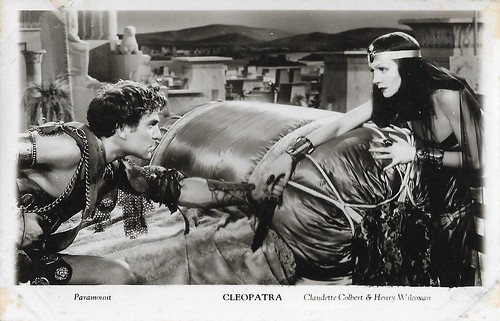
British postcard in the "Filmshots" series by Film Weekly. Photo: Paramount. Henry Wilcoxon as Mark Antony and Claudette Colbert as Cleopatra in Cleopatra (Cecil B. DeMille, 1934).
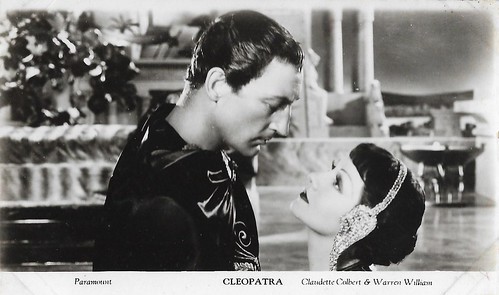
British postcard in the "Filmshots" series by Film Weekly. Photo: Paramount. Warren William as Julius Caesar and Claudette Colbert as Cleopatra in Cleopatra (Cecil B. DeMille, 1934).
After his historical epic Sign of the Cross (1932), Cecil B. DeMille directed another ancient spectacle, Cleopatra (1934). His new star Claudette Colbert , fresh from her donkey milk bath in Sign of The Cross, played the politically shrewd, man-hungry queen of Egypt. In 48 BC, Cleopatra, facing palace revolt, welcomes the arrival of Julius Caesar (Warren William) as a way of solidifying her power under Rome. When Caesar, whom she has led astray, is killed, she transfers her affections to Marc Antony ( Henry Wilcoxon ) and dazzles him on a lavish barge. The film got five Oscar nominations, including one for Best Picture, and Victor Milner won the award for Best Cinematography.
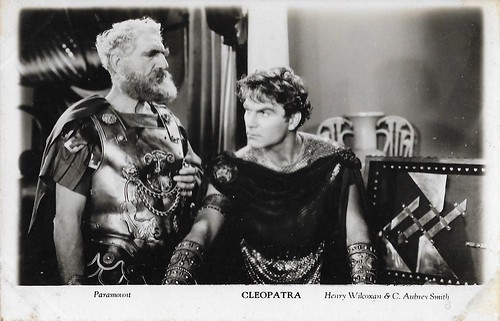
British postcard in the "Filmshots" series by Film Weekly. Photo: Paramount. Henry Wilcoxon as Mark Antony and C. Aubrey Smith as Enobarbus in Cleopatra (Cecil B. DeMille, 1934).
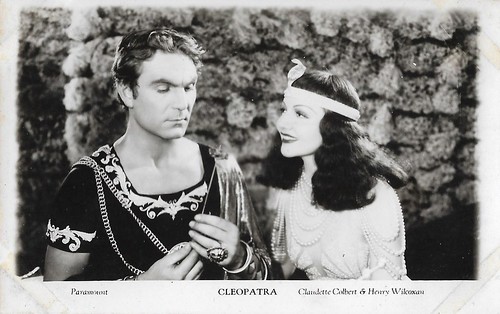
British postcard in the "Filmshots" series by Film Weekly. Photo: Paramount. Henry Wilcoxon as Mark Antony and Claudette Colbert as Cleopatra in Cleopatra (Cecil B. DeMille, 1934).
I Cover the Waterfront (1933)
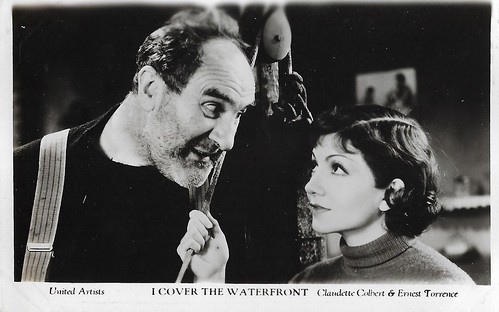
British postcard in the "Filmshots" series by Film Weekly. Photo: United Artists. Claudette Colbert and Ernest Torrence in I Cover the Waterfront (James Cruze, 1933).

British postcard in the "Filmshots" series by Film Weekly. Photo: United Artists. Claudette Colbert, Ernest Torrence and Ben Lyon in I Cover the Waterfront (James Cruze, 1933). The other woman could be Claudia Coleman.
I Cover the Waterfront (James Cruze, 1933) is a tough pre-code drama set at the Californian waterfront. The film deals with Kirk, an old smuggler ( Ernest Torrence in his final film role), who smuggles Chinese people into the country but has no remorse to throw his living cargo overboard when the police are after him. Yet, his daughter Julie ( Claudette Colbert ) remains loyal to him. An investigative reporter, Miller (Ben Lyon), bored of his area (he covers the waterfront, hence the title), is set on the case. He discovers a girl (Colbert) swimming naked at night and discovers she is the smuggler's daughter, so he woes her to get closer to the smuggler. She shows him the beauties of the waterfront, inspiring him to improve a novel he has been working on for years. However, unknowingly Julie betrays Kirk's next smuggle to Miller and he warns the Coast Guard. The whole affair ends badly for Kirk (he is deadly wounded), but not before he realizes Julie's love for Miller and manages to save Miller's life whom he has wounded himself.

British postcard in the "Filmshots" series by Film Weekly. Photo: United Artists. Claudette Colbert and Ben Lyon in I Cover the Waterfront (James Cruze, 1933).
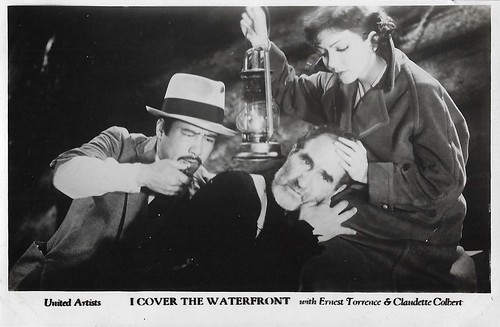
British postcard in the "Filmshots" series by Film Weekly. Photo: United Artists. Claudette Colbert and Ernest Torrence in I Cover the Waterfront (James Cruze, 1933).
Jennie Gerhardt (1933)
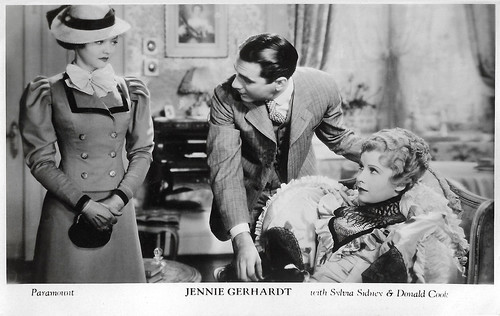
British postcard in the "Filmshots" series by Film Weekly. Photo: Paramount. Sylvia Sidney and Donald Cook in Jennie Gerhardt (Marion Gering, 1933).

British postcard in the "Filmshots" series by Film Weekly. Photo: Paramount. Sylvia Sidney and Greta Meyer in Jennie Gerhardt (Marion Gering, 1933).
Jennie Gerhardt (1933) is an American pre-Code drama film directed by Marion Gering for Paramount Pictures. It stars Sylvia Sidney, Mary Astor, Donald Cook, Edward Arnold, and H.B. Warner. The film is based on the 1911 novel 'Jennie Gerhardt' by Theodore Dreiser. Jennie Gerhardt (Sylvia Sidney) is a destitute young woman. While working in a hotel in Columbus, Ohio, Jennie meets George Brander (Edward Arnold), a United States Senator, who becomes infatuated with her. He helps her family and declares his wish to marry her. Jennie, grateful for his benevolence, agrees to sleep with him. He dies before they marry, and Jennie is pregnant. Jenny meets Lester Kane (Donald Cook), a prosperous manufacturer's son. Jennie falls in love with him, impressed by his strong will and generosity. She leaves her daughter Vesta (Cora Sue Collins) in Cleveland and travels to New York with Kane. He does not know of her illegitimate daughter and wants to marry Jennie. But because of their difference in class, he anticipates his family's disapproval and decides to take her as his mistress. Dreiser himself approved of the film, considering it to be "moving" and "beautifully interpreted". However, the film received a mixed critical reception upon release in June 1933. Motion Picture Herald said that Jennie Gerhardt is "strictly an adult picture. Selling it successfully depends upon your ability to construct campaigns that will intrigue human interest and sympathy in the character of Jennie." Mordaunt Hall of The New York Times stated that "although the film is handicapped by a lack of suspense and some choppy and trite dialogue, it possesses a laudable sincerity, which may result in its being popular with those who are partial to this genre of story."

British postcard in the "Filmshots" series by Film Weekly. Photo: Paramount. Sylvia Sidney and Edward Arnold in Jennie Gerhardt (Marion Gering, 1933).
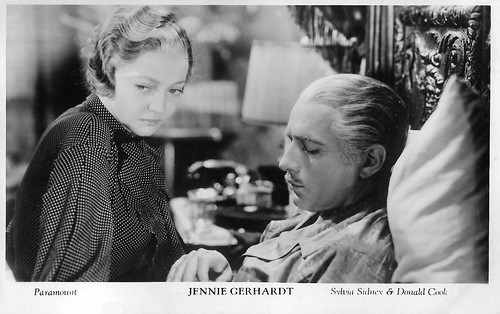
British postcard in the "Filmshots" series by Film Weekly. Photo: Paramount. Sylvia Sidney and Donald Cook in Jennie Gerhardt (Marion Gering, 1933).
The Bowery (1933)
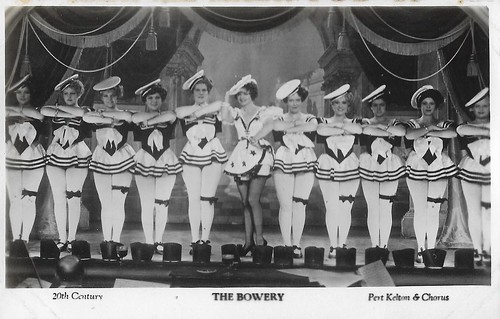
British postcard in the "Filmshots" series by Film Weekly. Photo: Twentieth Century. Pert Kelton as dance hall performer Trixie Odbray with the chorus in The Bowery (Raoul Walsh, 1933).
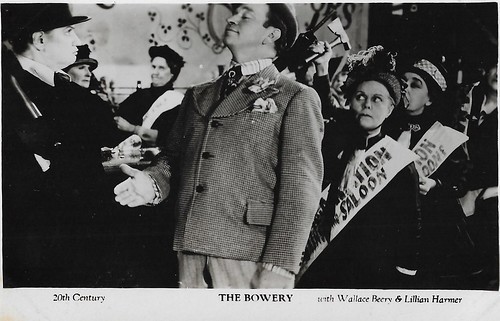
British postcard in the "Filmshots" series by Film Weekly. Photo: Twentieth Century. Wallace Beery and Lillian Harmer in The Bowery (Raoul Walsh, 1933).
The Bowery (Raoul Walsh, 1933) is set in the Gay Nineties in the Bowery in New York. Saloon owner Chuck Connors ( Wallace Beery ) is the king of the Bowery. He adopts a boy, Swipes ( Jackie Cooper ), and educates him in a rough way. Connors' rival, both as an upcoming saloon owner and in the voluntary fire brigade, is Steve Brodie (George Raft). Soon, both also become rivals in the love of Lucy ( Fay Wray ), a homeless girl Connors has saved - causing the jealous Swipes to move in with Brodie. Connors bets his saloon against Brodie to challenge him to jump off the Brooklyn Bridge. Brodie eventually does so when his plan to use a dummy falls through. Connors then sees no problem when temperance activists destroy his saloon. Until he hears about the dummy...
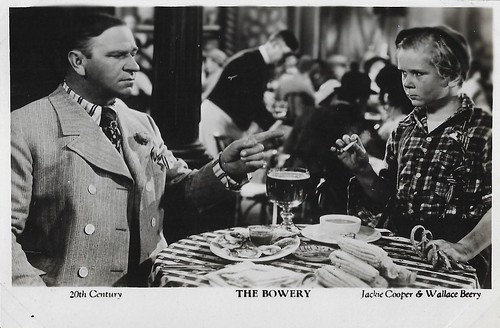
British postcard in the "Filmshots" series by Film Weekly. Photo: Twentieth Century. Wallace Beery and Jackie Cooper in The Bowery (Raoul Walsh, 1933).
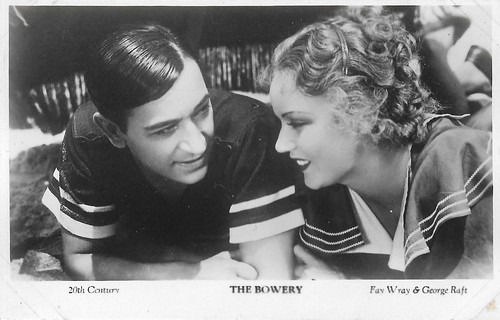
British postcard in the "Filmshots" series by Film Weekly. Photo: Twentieth Century. Fay Wray and George Raft in The Bowery (Raoul Walsh, 1933).
Catherine the Great (1934)
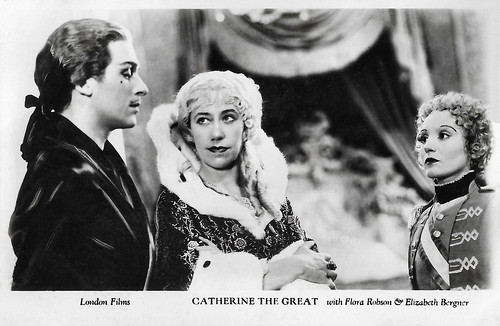
British postcard in the "Filmshots" series by Film Weekly. Photo: London Films. Douglas Fairbanks Jr. , Flora Robson, and Elisabeth Bergner in Catherine the Great (Paul Czinner, 1934).

British postcard in the "Filmshots" series by Film Weekly. Photo: London Films. Publicity still for Catherine the Great (Paul Czinner, 1934). Although the postcard credits the kissing lady as Elisabeth Bergner , we think she is Diana Napier who portrays Countess Vorontzova, the mistress of Peter III ( Douglas Fairbanks Jr. ).
Catherine the Great/The Rise of Catherine the Great (1934) was the first English-language film for Vienna-born Elisabeth Bergner . She is radiant as the obscure German princess who would become the most powerful woman in Russian history. Bergner definitely makes Catherine interesting and worth caring about. The historical film was based on the play 'The Czarina' by two Hungarian writers, Lajos Bíró and Melchior Lengyel. It was directed by Bergner's husband Paul Czinner and - uncredited - by producer Alexander Korda. Grand Duke Pyotr, who later became Peter III, was played by Douglas Fairbanks Junior . He behaves like a homicidal Hamlet, all moodiness and flares of deadly temper. He makes an interesting effort to create a charmer out of a pathetic man who was obviously a maniac. The supporting cast is also excellent. Dame Flora Robson is wonderful as Empress Elizabeth: suspicious, domineering, and rather wanton. Celebrated stage actress Dame Irene Vanbrugh makes a rare screen appearance as Catherine's mother. The mid-eighteenth century was a period when clothes and furnishings favoured by the wealthy classes of Europe were particularly fanciful and elaborate, and this is reflected in the lavish sets and costumes on view in the film. Although the film was overshadowed by Josef von Sternberg's masterpiece The Scarlet Empress (1934) with Marlene Dietrich, Catherine the Great/The Rise of Catherine the Great is a good film taken on its own merits.
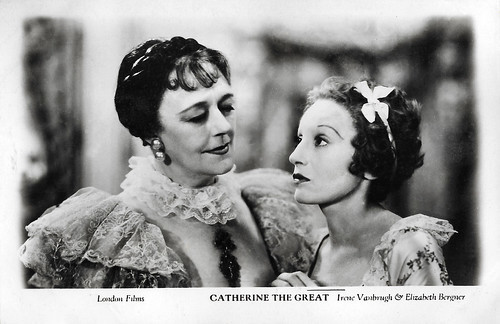
British postcard in the "Filmshots" series by Film Weekly. Photo: London Films. Irene Vanbrugh and Elisabeth Bergner in Catherine the Great (Paul Czinner, 1934).
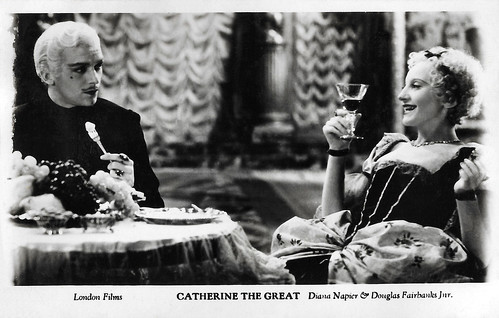
British postcard in the "Filmshots" series by Film Weekly. Photo: London Films. Douglas Fairbanks Jr. and Diana Napier in Catherine the Great (Paul Czinner, 1934).
Check out the three earlier Film Weekly posts at EFSP: 7 March 2020 including The Private Life of Henry VIII (1933), 14 March 2020 including A Farewell to Arms (1932), and 28 November 2020 including Christopher Strong (1933).
Cleopatra (1934)

British postcard in the "Filmshots" series by Film Weekly. Photo: Paramount. Henry Wilcoxon as Mark Antony and Claudette Colbert as Cleopatra in Cleopatra (Cecil B. DeMille, 1934).

British postcard in the "Filmshots" series by Film Weekly. Photo: Paramount. Warren William as Julius Caesar and Claudette Colbert as Cleopatra in Cleopatra (Cecil B. DeMille, 1934).
After his historical epic Sign of the Cross (1932), Cecil B. DeMille directed another ancient spectacle, Cleopatra (1934). His new star Claudette Colbert , fresh from her donkey milk bath in Sign of The Cross, played the politically shrewd, man-hungry queen of Egypt. In 48 BC, Cleopatra, facing palace revolt, welcomes the arrival of Julius Caesar (Warren William) as a way of solidifying her power under Rome. When Caesar, whom she has led astray, is killed, she transfers her affections to Marc Antony ( Henry Wilcoxon ) and dazzles him on a lavish barge. The film got five Oscar nominations, including one for Best Picture, and Victor Milner won the award for Best Cinematography.

British postcard in the "Filmshots" series by Film Weekly. Photo: Paramount. Henry Wilcoxon as Mark Antony and C. Aubrey Smith as Enobarbus in Cleopatra (Cecil B. DeMille, 1934).

British postcard in the "Filmshots" series by Film Weekly. Photo: Paramount. Henry Wilcoxon as Mark Antony and Claudette Colbert as Cleopatra in Cleopatra (Cecil B. DeMille, 1934).
I Cover the Waterfront (1933)

British postcard in the "Filmshots" series by Film Weekly. Photo: United Artists. Claudette Colbert and Ernest Torrence in I Cover the Waterfront (James Cruze, 1933).

British postcard in the "Filmshots" series by Film Weekly. Photo: United Artists. Claudette Colbert, Ernest Torrence and Ben Lyon in I Cover the Waterfront (James Cruze, 1933). The other woman could be Claudia Coleman.
I Cover the Waterfront (James Cruze, 1933) is a tough pre-code drama set at the Californian waterfront. The film deals with Kirk, an old smuggler ( Ernest Torrence in his final film role), who smuggles Chinese people into the country but has no remorse to throw his living cargo overboard when the police are after him. Yet, his daughter Julie ( Claudette Colbert ) remains loyal to him. An investigative reporter, Miller (Ben Lyon), bored of his area (he covers the waterfront, hence the title), is set on the case. He discovers a girl (Colbert) swimming naked at night and discovers she is the smuggler's daughter, so he woes her to get closer to the smuggler. She shows him the beauties of the waterfront, inspiring him to improve a novel he has been working on for years. However, unknowingly Julie betrays Kirk's next smuggle to Miller and he warns the Coast Guard. The whole affair ends badly for Kirk (he is deadly wounded), but not before he realizes Julie's love for Miller and manages to save Miller's life whom he has wounded himself.

British postcard in the "Filmshots" series by Film Weekly. Photo: United Artists. Claudette Colbert and Ben Lyon in I Cover the Waterfront (James Cruze, 1933).

British postcard in the "Filmshots" series by Film Weekly. Photo: United Artists. Claudette Colbert and Ernest Torrence in I Cover the Waterfront (James Cruze, 1933).
Jennie Gerhardt (1933)

British postcard in the "Filmshots" series by Film Weekly. Photo: Paramount. Sylvia Sidney and Donald Cook in Jennie Gerhardt (Marion Gering, 1933).

British postcard in the "Filmshots" series by Film Weekly. Photo: Paramount. Sylvia Sidney and Greta Meyer in Jennie Gerhardt (Marion Gering, 1933).
Jennie Gerhardt (1933) is an American pre-Code drama film directed by Marion Gering for Paramount Pictures. It stars Sylvia Sidney, Mary Astor, Donald Cook, Edward Arnold, and H.B. Warner. The film is based on the 1911 novel 'Jennie Gerhardt' by Theodore Dreiser. Jennie Gerhardt (Sylvia Sidney) is a destitute young woman. While working in a hotel in Columbus, Ohio, Jennie meets George Brander (Edward Arnold), a United States Senator, who becomes infatuated with her. He helps her family and declares his wish to marry her. Jennie, grateful for his benevolence, agrees to sleep with him. He dies before they marry, and Jennie is pregnant. Jenny meets Lester Kane (Donald Cook), a prosperous manufacturer's son. Jennie falls in love with him, impressed by his strong will and generosity. She leaves her daughter Vesta (Cora Sue Collins) in Cleveland and travels to New York with Kane. He does not know of her illegitimate daughter and wants to marry Jennie. But because of their difference in class, he anticipates his family's disapproval and decides to take her as his mistress. Dreiser himself approved of the film, considering it to be "moving" and "beautifully interpreted". However, the film received a mixed critical reception upon release in June 1933. Motion Picture Herald said that Jennie Gerhardt is "strictly an adult picture. Selling it successfully depends upon your ability to construct campaigns that will intrigue human interest and sympathy in the character of Jennie." Mordaunt Hall of The New York Times stated that "although the film is handicapped by a lack of suspense and some choppy and trite dialogue, it possesses a laudable sincerity, which may result in its being popular with those who are partial to this genre of story."

British postcard in the "Filmshots" series by Film Weekly. Photo: Paramount. Sylvia Sidney and Edward Arnold in Jennie Gerhardt (Marion Gering, 1933).

British postcard in the "Filmshots" series by Film Weekly. Photo: Paramount. Sylvia Sidney and Donald Cook in Jennie Gerhardt (Marion Gering, 1933).
The Bowery (1933)

British postcard in the "Filmshots" series by Film Weekly. Photo: Twentieth Century. Pert Kelton as dance hall performer Trixie Odbray with the chorus in The Bowery (Raoul Walsh, 1933).

British postcard in the "Filmshots" series by Film Weekly. Photo: Twentieth Century. Wallace Beery and Lillian Harmer in The Bowery (Raoul Walsh, 1933).
The Bowery (Raoul Walsh, 1933) is set in the Gay Nineties in the Bowery in New York. Saloon owner Chuck Connors ( Wallace Beery ) is the king of the Bowery. He adopts a boy, Swipes ( Jackie Cooper ), and educates him in a rough way. Connors' rival, both as an upcoming saloon owner and in the voluntary fire brigade, is Steve Brodie (George Raft). Soon, both also become rivals in the love of Lucy ( Fay Wray ), a homeless girl Connors has saved - causing the jealous Swipes to move in with Brodie. Connors bets his saloon against Brodie to challenge him to jump off the Brooklyn Bridge. Brodie eventually does so when his plan to use a dummy falls through. Connors then sees no problem when temperance activists destroy his saloon. Until he hears about the dummy...

British postcard in the "Filmshots" series by Film Weekly. Photo: Twentieth Century. Wallace Beery and Jackie Cooper in The Bowery (Raoul Walsh, 1933).

British postcard in the "Filmshots" series by Film Weekly. Photo: Twentieth Century. Fay Wray and George Raft in The Bowery (Raoul Walsh, 1933).
Catherine the Great (1934)

British postcard in the "Filmshots" series by Film Weekly. Photo: London Films. Douglas Fairbanks Jr. , Flora Robson, and Elisabeth Bergner in Catherine the Great (Paul Czinner, 1934).

British postcard in the "Filmshots" series by Film Weekly. Photo: London Films. Publicity still for Catherine the Great (Paul Czinner, 1934). Although the postcard credits the kissing lady as Elisabeth Bergner , we think she is Diana Napier who portrays Countess Vorontzova, the mistress of Peter III ( Douglas Fairbanks Jr. ).
Catherine the Great/The Rise of Catherine the Great (1934) was the first English-language film for Vienna-born Elisabeth Bergner . She is radiant as the obscure German princess who would become the most powerful woman in Russian history. Bergner definitely makes Catherine interesting and worth caring about. The historical film was based on the play 'The Czarina' by two Hungarian writers, Lajos Bíró and Melchior Lengyel. It was directed by Bergner's husband Paul Czinner and - uncredited - by producer Alexander Korda. Grand Duke Pyotr, who later became Peter III, was played by Douglas Fairbanks Junior . He behaves like a homicidal Hamlet, all moodiness and flares of deadly temper. He makes an interesting effort to create a charmer out of a pathetic man who was obviously a maniac. The supporting cast is also excellent. Dame Flora Robson is wonderful as Empress Elizabeth: suspicious, domineering, and rather wanton. Celebrated stage actress Dame Irene Vanbrugh makes a rare screen appearance as Catherine's mother. The mid-eighteenth century was a period when clothes and furnishings favoured by the wealthy classes of Europe were particularly fanciful and elaborate, and this is reflected in the lavish sets and costumes on view in the film. Although the film was overshadowed by Josef von Sternberg's masterpiece The Scarlet Empress (1934) with Marlene Dietrich, Catherine the Great/The Rise of Catherine the Great is a good film taken on its own merits.

British postcard in the "Filmshots" series by Film Weekly. Photo: London Films. Irene Vanbrugh and Elisabeth Bergner in Catherine the Great (Paul Czinner, 1934).

British postcard in the "Filmshots" series by Film Weekly. Photo: London Films. Douglas Fairbanks Jr. and Diana Napier in Catherine the Great (Paul Czinner, 1934).
Check out the three earlier Film Weekly posts at EFSP: 7 March 2020 including The Private Life of Henry VIII (1933), 14 March 2020 including A Farewell to Arms (1932), and 28 November 2020 including Christopher Strong (1933).
Published on May 21, 2021 22:00
Paul van Yperen's Blog
- Paul van Yperen's profile
- 13 followers
Paul van Yperen isn't a Goodreads Author
(yet),
but they
do have a blog,
so here are some recent posts imported from
their feed.



